- Getting pregnant
- Life as a parent
- Baby Products
- Birth Clubs
- See all in Community
- Ovulation Calculator
- How long will it take to conceive?
- When to take a pregnancy test
- Best positions to conceive
- Top signs of pregnancy
- How to use ovulation kits
- How age affects fertility
- When can I get pregnant after c-section?
- What fertile cervical mucus looks like
- Late period but no pregnancy
- Faint line on pregnancy test
- See all in Getting Pregnant
- How big is my baby?
- Due Date Calculator
- Painful baby movements
- Symptoms you should never ignore
- Hospital bag packing checklist
- How your baby's developing
- Signs of labour
- How to tell baby position by kicks
- Baby movements: boy or girl?
- How to count pregnancy months & weeks
- Nuchal Translucency (NT) scan
- Baby Weight Chart
- See all in Pregnancy
- Baby Name Finder
- Modern Indian Baby Names
- Most Popular Names in India
- Baby Names inspired by the Quran
- Baby Names inspired by Lord Shiva
- Sanskrit Baby Names
- See all in Baby Names
- Your baby week by week
- Baby milestones by month
- Baby Rashes
- Baby skin colour
- Worms in babies and toddlers
- Sleep training methods
- Baby teething remedies
- How to do steaming for a baby
- See all in Baby
- Your toddler month by month
- How much water should toddlers drink?
- When your toddler gets frustrated
- Vegetarian meals for toddlers
- When your toddler won't eat
- Potty training
- Help your toddler sleep
- Bottle to cup
- Games & activities
- What to feed a sick toddler
- See all in Toddler
- गर्भवती होने के लिए संभोग
- प्रेगनेंसी टेस्ट में हल्की रेखा का मतलब
- गर्भावस्था के लक्षण
- गर्भावस्था में खून के धब्बे (ब्लीडिंग)
- गर्भावस्था में शिशु की हलचल
- प्रसव पीड़ा (लेबर पेन) के लक्षण
- शिशु के नक्षत्र पर आधारित नाम
- शिशु को कितनी मात्रा में फॉर्मूला दूध देना है?
- बच्चे के पेट में कीड़े: लक्षण व इलाज
- हिंदी अनुभाग देखें
- Postnatal symptoms to watch out for
- Pain and stitches after delivery
- Postnatal massage
- Postnatal diet
- Post-delivery confinement
- See all in Life as a parent
- Best Maternity Bras
- 9 Breastfeeding Pillows You'll Love!
- Best Strollers for You and Your Baby
- Best Baby Carriers
- 10 Best Baby High Chairs
- Best Baby Walking Toys
- See all in Baby Products
- Astrology names
- Goddess Lakshmi names
- Baby names by date of birth
- Conjunctivitis
- Combination baby names
- Goddess Durga names
- Sikh baby names
- Bengali baby names
- Eclipses and pregnancy
- Name numerology
- Lord Vishnu names
- What to feed baby with a fever
- Traditional Indian names
- Gestational age vs fetal age
- South Indian baby names
- Mythological baby names
- Pregnancy food chart
- Names that rhyme
- Goddess Saraswati names
- Are air conditioners safe for babies?
- Annaprashan rice ceremony
- Nature names
- Godh bharai: baby shower
- Sesame seeds in pregnancy

Is it safe to travel by a two or three wheeler during pregnancy?

Riding a two wheeler in pregnancy
Travelling by auto or rikshaw in pregnancy.
- Three-wheeled vehicles have less stability and balance than four-wheeled ones.
- They don't have basic safety features such as a seat belt, suspension, an airbag etc.
- They are open and so leave you more vulnerable to injury if they topple over or from flying debris.
- They travel on the same roads as cars, trucks and busses that go much faster and have a much stronger build. Even a minor collision with any of these other kinds of vehicles would damage the auto or rikshaw proportionately more, leaving you more vulnerable to injury.
- Ask the driver before you get in to drive slowly and carefully. If you feel comfortable with it, you can even tell him you're expecting so that he takes you seriously.
- Try to use autos and rikshaws only for short trips.
- If possible, plan your outing outside of peak traffic times to avoid chaotic roads that make travelling more dangerous.
- Use a face mask to protect yourself from the pollution, dust and unpleasant smells that might trigger nausea .
- Carry water, especially in hot weather when warm winds can make you dehydrated quickly.
- Hold on tight to the handlebars.
Alternatives to two and three wheel transportation in pregnancy
- Arrange a car pool. Whether it's to drop an older child to school, or to go to office yourself, car pools can be very useful.
- Use public transport. With more modern busses and metros coming up in most big cities, public transport is a good option and much safer for daily commutes.
- Rely more on home deliveries where possible to reduce your need to go out.
- Check with your office if you can work from home for a few days a week.
- See if you can share a cab with colleagues.
- Can a bumpy road bring on labour?
- Pregnancy travel: where to go and how to decide
- How to tell your employer you're expecting
Was this article helpful?
Is it safe to walk through metal detectors and screening machines when pregnant?
How to handle work related trips during pregnancy.

Travelling by bus when pregnant

Is it safe to use insect repellent during pregnancy?

BabyCenter's editorial team is committed to providing the most helpful and trustworthy pregnancy and parenting information in the world. When creating and updating content, we rely on credible sources: respected health organisations, professional groups of doctors and other experts, and published studies in peer-reviewed journals. We believe you should always know the source of the information you're seeing. Learn more about our editorial and medical review policies .

Where to go next

- Trying to Conceive
- Signs & Symptoms
- Pregnancy Tests
- Fertility Testing
- Fertility Treatment
- Weeks & Trimesters
- Staying Healthy
- Preparing for Baby
- Complications & Concerns
- Pregnancy Loss
- Breastfeeding
- School-Aged Kids
- Raising Kids
- Personal Stories
- Everyday Wellness
- Safety & First Aid
- Immunizations
- Food & Nutrition
- Active Play
- Pregnancy Products
- Nursery & Sleep Products
- Nursing & Feeding Products
- Clothing & Accessories
- Toys & Gifts
- Ovulation Calculator
- Pregnancy Due Date Calculator
- How to Talk About Postpartum Depression
- Editorial Process
- Meet Our Review Board
Is Riding a Bike Safe While Pregnant?
verve231 / Getty Images
Bike Riding While Pregnant
Safety precautions, other considerations.
If you love riding your bike to work or along bike paths, you may be wondering if it's safe to ride a bike while pregnant. Whether you are concerned about the intensity of the exercise , the way pedaling brings your knees up toward your baby bump or even the risk of falling off your bike we have some good news.
Certified personal trainer and founder of Every Mother, Leah Keller , assures us, "Bike riding is a safe, low-impact option for aerobic exercise that can be enjoyed throughout the entire pregnancy."
There's no need to switch your commute method or change your exercise routine if a bicycle is your preferred choice. As long as you still feel like riding and your doctor says it's OK, it is safe to ride a bike while pregnant.
Bike riding while pregnant is not exactly the same thing as your usual bike riding, however. There are a few safety precautions to keep in mind if you choose to cycle while expecting. And remember, you should always check with your doctor to make sure that any kind of exercise is safe for you, especially if you have a high-risk pregnancy.
Overall, peddling a bike while pregnant is a safe, low-impact aerobic exercise to do while pregnant. "Generally speaking, the bio-mechanical risks associated with bike riding are minimal," Keller says.
The biggest risk involved with cycling while pregnant is the possibility of falling.
How prone you are to falling depends on a variety of factors, including the terrain, the traffic, and your level of experience. If bike riding is not something you took part in before you became pregnant, now is probably not a good time to start. In general, stick with aerobic exercises you are already familiar with when you are expecting.
When riding a bike, a helmet is the most important piece of protective gear you need, regardless of whether you're pregnant or not. Falls while bike riding can leave you with some nasty cuts and bruises as well as a head injury.
Accidental falls also may hurt your baby and can even cause miscarriage, so it is worth considering whether you feel comfortable continuing this type of exercise. The good news is, you can get the same physical benefits from a stationary bicycle while greatly reducing your risk of falling.
If you do decide to ride a bike while pregnant—and your doctor gives the OK—you will want to take whatever precautions necessary to protect your developing child from a potential fall. The main way to do that is to reduce your risk of falling, whether that is by choosing flat terrain, making sure your bike fits you properly or deciding to stop when you feel begin to feel off-balance later in pregnancy.
Stationary Bikes
Keller says that stationary bike riding is a suitable alternative for pregnant people. She also says it's a "safer option that offers the same cardiovascular and low-impact benefits of cycling with essentially no risk of falling."
Both the environment and your changing body add to your risk of falling on a road or mountain bike, but with a stationary bike, those factors all but disappear. Like outdoor bike riding, stationary bike riding also can help stabilize blood sugar, improve circulation, boost energy, and prepare you to have both stamina and strength for labor.
Because any fall can cause abdominal trauma, Keller generally advises against outdoor cycling during pregnancy, saying that indoor cycling is a safer choice.
"Even an experienced cyclist faces new balance and stability challenges during pregnancy due to a rapidly changing center of gravity and ligament laxity. Outdoor cycling presents many risks beyond our control - such as traffic, a sudden change of weather that could make familiar terrain more treacherous, unpredictable pedestrians, and other cyclists," she says.
Whether you choose to hit the road or a stationary bike, remember that as with any kind of physical activity throughout your pregnancy , it is important to read your body's cues and listen to what it is telling you. If something feels uncomfortable, stop or slow down.
"Sometimes cycling can become less comfortable if you are carrying low, or if the baby has dropped lower in the pelvis toward the end of the pregnancy," Keller explains. If this is the case, you may feel more comfortable replacing cycling with walking or swimming as alternative forms of safe, low impact aerobic activity, she says.
Staying hydrated also is vital for both your health and the baby's when you are pregnant, so take extra care to drink enough fluids when biking. Keller also suggests cycling in a well-ventilated area if you choose to stick with stationary bike riding.
Pregnancy may not be the time to push yourself to ride your fastest or farthest.
Instead of maximizing your efforts, Keller advises keeping your exertion intensity moderate. "A good self-check on intensity level is the 'talk test,'" she says. "If you can carry on a light conversation while cycling, that is a good sign you are not overdoing the intensity."
Being pregnant doesn't mean you can't work up a sweat, though. It's actually beneficial to get your heart pumping regularly while you're expecting. Aerobic exercise is beneficial to your health and it is an important type of exercise to get when you are pregnant.
"If you could sing an opera while riding [a stationary bike], you could pedal a little bit harder," Keller says. Again, you probably don't want to push yourself on a regular bike due to the risk of falling.
Mindfully increase either your speed or your resistance to boost your benefit from a stationary bike workout if you feel like you're not pushing yourself enough to get the cardiovascular exercise you need. "Striving for that sweet spot of feeling slightly winded yet still invigorated is ideal," says Keller.
Biking is a low-impact aerobic exercise, but external factors like rough terrain should be considered when you are expecting. To keep your baby and yourself safe, Keller says, "Make sure you feel in control of your body at all times and avoid pedaling so fast that you bounce in the seat."
Keller notes that making sure your bike fits properly and is well maintained can help keep prevent falls or muscle stiffness from riding in an awkward position. Warming up and cooling down, as well as pacing yourself throughout the ride are also important parts of safe bike riding, but these factors are even more important to take into account during pregnancy.
"[If you're riding a stationary bike,] warm up with a light ride to begin, and challenge yourself to work hard in small bursts with active, light recovery between the harder intervals," Keller suggests. "End with an easy cool down to allow your heart rate to gradually decrease, and enjoy some gentle stretches after you finish."
What If Bike Riding Isn't Working?
If you are uncomfortable when you ride or for any reason biking just doesn't feel right, you may want to stop biking. You can always start riding again when you are no longer pregnant.
If you still want to get the positive physical benefits that riding a bike provides, you can switch to another form of low-impact aerobic exercise for the duration of your pregnancy. Swimming , walking, and yoga all offer the same positive benefits as biking.
A Word From Verywell
Riding a bike is a good way to get exercise when you are pregnant, but you may not feel comfortable with the fall risk. If you love zooming down trails on your bike and indoor cycling just does not make you feel inspired, take heart.
You can always get back into outdoor biking after your baby is born, and depending on where you live, you may be able to take your little one along as early as 1 year old. A stationary bike can help keep you in shape until then.
San Lazaro Campillo I, Meaney S, Sheehan J, Rice R, O’Donoghue K. University students’ awareness of causes and risk factors of miscarriage: a cross-sectional study . BMC Women’s Health . 2018;18(1):188. doi:10.1186/s12905-018-0682-1
Ong MJ, Wallman KE, Fournier PA, Newnham JP, Guelfi KJ. Enhancing energy expenditure and enjoyment of exercise during pregnancy through the addition of brief higher intensity intervals to traditional continuous moderate-intensity cycling . BMC Pregnancy and Childbirth . 2016;16(1):161. doi:10.1186/s12884-016-0947-3
Downs DS, Chasan-Taber L, Evenson KR, Leiferman J, Yeo S. Physical activity and pregnancy . Research Quarterly for Exercise and Sport . 2012;83(4):485-502. doi:10.1080/02701367.2012.10599138
By Elisa Cinelli Elisa is a well-known parenting writer who is passionate about providing research-based content to help parents make the best decisions for their families. She has written for well-known sites including POPSUGAR and Scary Mommy, among others.
When you buy through links on our site, we may earn an affiliate commission. Learn more.
Can You Ride a Bike While Pregnant? (Myths vs Facts for a Safe Exercise)
So here’s the deal, my friend. You’ve got this incredulous question twirling in your mind, and frankly, I’ve tussled with it myself. Can you, indeed, mount on that bike and ride along those scenic paths, even with a bun in the oven? We’re talking, are you able to ride a bike while pregnant?
See, I understand the lure of the wind caressing your face, the sun kissing your skin, and the gentle hum of wheels against the pavement. Oh boy, I get it! But pregnancy, it brings a whole new layer of complexity, doesn’t it? Suddenly, there’s not just you but also this tiny human, snug and cozy inside of you, who you’ve got to think about.
Well, don’t you fret! Because I’ve done some homework. I’ve searched high and low, bounced between expert opinions, and now I’m here to share what I’ve learned. So let’s tackle this query together, and by the end, you’ll have a clear answer to your question.
Let’s navigate the winding roads of pregnancy and biking together. So, dear reader, buckle up, and let’s roll down this road of discovery together.
Understanding the Safety of Bike Riding During Pregnancy
In my opinion, and backed by research, bike riding during pregnancy is possible and carries numerous health benefits for both mother and child. However, it’s important to carefully assess the safety of this physical activity, considering that pregnancy can cause changes to the body that might affect balance and mobility.

Is Bike Riding Safe During Pregnancy?
From what I’ve seen, many health professionals advocate for continued physical activity during pregnancy, including biking. However, this is generally under the understanding that the cycling is low-risk and more controlled, such as stationary cycling indoors. High-risk activities like horseback riding or off-road biking are typically advised against due to the increased risk of falls and jolts.
Assessing the Potential Risks of Bike Riding While Pregnant
I think it’s important to acknowledge that the biggest risk associated with cycling while pregnant is falling. Your center of gravity shifts as your belly grows, which can affect your balance. However, if you’re an experienced cyclist, your risk might be lower, but still present.
Understanding Your Ability Level
Assessing your cycling ability when pregnant.
Not all cyclists are equal, and your ability level can greatly impact the safety and effectiveness of cycling while pregnant. It’s important to honestly assess your cycling ability and comfort level. Remember to ease off the gas and adjust your cycling routine to accommodate the physical changes you’re experiencing.
Guidelines for Bike Riding While Pregnant
While cycling can be beneficial during pregnancy, it’s necessary to adhere to certain guidelines to ensure both your safety and the safety of your unborn child. Here are some things you should keep in mind.
Scaling Back: Adjusting Your Cycling Routine
While you may have been able to handle intense cycling sessions pre-pregnancy, it’s advisable to scale back and modify your routine now. Moderate-intensity exercise is recommended during pregnancy, and it’s important not to exhaust yourself. You should still be able to hold a conversation while cycling.
Maintaining Balance During Pregnancy
As your pregnancy progresses, maintaining your balance while cycling can become more challenging. To cope with this, you can lower your center of gravity by adjusting your saddle height. This can increase your stability and reduce the risk of falls.
Importance of Proper Gear While Cycling Pregnant
Having the right gear is always important when cycling, but it becomes even more so when you’re pregnant. A well-fitted helmet, comfortable clothing, and a bike that’s adjusted to accommodate your changing body can make your rides safer and more enjoyable.
Assessing Your Safety: Precautions to Consider
I think it’s very important to prioritize safety while engaging in any physical activity during pregnancy, and cycling is no exception. This means avoiding risky situations like off-road cycling or highly trafficked areas, and always wearing your safety gear.
Benefits of Cycling During Pregnancy
The health benefits of exercising while pregnant.
In addition to providing a good level of exercise, cycling also offers numerous health benefits during pregnancy. Some of these include reduced risk of gestational diabetes, backaches, constipation, bloating, and swelling. It can also boost mood, energy levels, and improve sleep quality.

The Role of Hydration in Pregnancy and Cycling
The importance of drinking plenty of water.
When it comes to cycling during pregnancy, hydration takes on a new level of importance. Water is vital for maintaining body fluid balance, carrying nutrients and oxygen to cells, flushing bacteria from the bladder, aiding digestion, and regulating body temperature, among other things. Therefore, it’s crucial to hydrate adequately before, during, and after your cycling sessions.
Cycling Partner: Is it Necessary?
The benefits of riding with a partner.
Having a cycling partner can offer a level of safety and comfort while cycling during pregnancy. They can help you maintain balance, offer assistance if need be, and provide company during your rides. However, don’t worry if you prefer to cycle solo – just ensure you’re taking all necessary safety precautions.
Cycling During Different Trimesters
The stage of your pregnancy can affect your ability and safety while cycling. Let’s look at how cycling can be approached during different trimesters.
Cycling During the First Trimester
Cycling during the first trimester is generally safe. For those who are comfortable on a bike, even dirt biking can be done for up to 6 weeks of pregnancy.
Cycling During the Second Trimester
During the second trimester, you may notice changes in your balance and mobility. It’s important to adjust your cycling routine accordingly, and consider switching to stationary biking if you haven’t already.
Cycling During the Third Trimester
In the third trimester, maintaining balance on a bicycle can become increasingly challenging. At this stage, many opt for stationary indoor cycling for safety and comfort.

Can Cycling Cause Miscarriage?
Understanding the link between cycling and miscarriage.
There is no direct link between moderate, safe cycling and increased risk of miscarriage. However, falls and accidents while cycling could potentially harm the baby, hence the emphasis on safety precautions.
Duration of Bike Riding While Pregnant
How long can you ride a bike while pregnant.
The length of your rides will depend on your comfort level, stamina, and how far along you are in your pregnancy. It’s recommended to avoid exhausting yourself and maintain the ability to hold a conversation during your rides.
Post-Pregnancy Cycling
Returning to cycling after pregnancy.
Returning to cycling after pregnancy may take some time, as your body needs to recover from childbirth. It’s crucial to ease back into cycling slowly and listen to your body’s signals.
Things to Know When Riding a Bike While Pregnant
Essential tips for cycling while pregnant.
When cycling during pregnancy, here are a few tips to keep in mind: – Adjust your bike fit and saddle to accommodate pelvic floor changes – Include cycling stretches for flexibility improvement – Build up your training slowly to avoid injuries – Wear appropriate protective gear – Stay hydrated – Listen to your body and take breaks when needed
In conclusion, cycling can be a safe, beneficial form of exercise during pregnancy when done properly and with the right precautions. Always consult with your healthcare provider before starting or continuing a cycling routine during pregnancy. Happy cycling!
Leave a Reply Cancel reply
Your email address will not be published. Required fields are marked *
Save my name, email, and website in this browser for the next time I comment.

Pedal Adventures
Your resource for mountain bike travel
Common Questions on Biking During the First Trimester
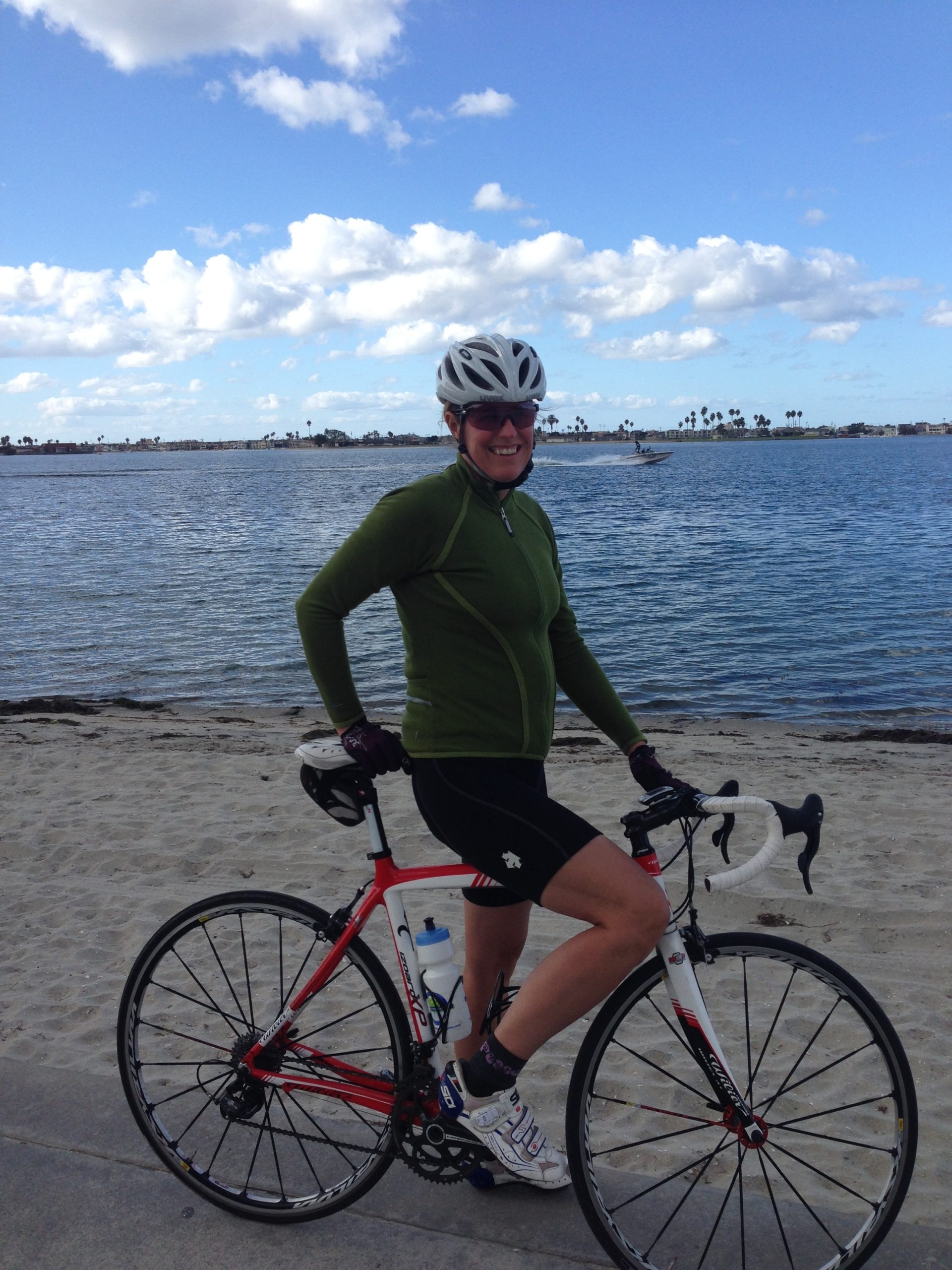
Is it safe for me and my baby to continue cycling pregnant?
If you are healthy, and are not a high risk pregnancy, it is safe to continue biking during the First Trimester. In fact, there are many benefits to you and your baby. As an active woman you are probably very in tune with your body. You will need to continue this sacred connection as it’s very important. Your instincts are important to insure you are never pushing too hard. Stop anytime you feel pain or even feel ‘off.’ Always check with your doctor if you are unsure of any symptoms you are experiencing.
Is there a limit to the amount I should bike?
There is no specific magic number that is used as a general guideline. If you have been regularly logging 50 miles a week, your pregnant mileage will vary as compared to someone who has been biking a few miles per week. This is a time to maintain your fitness – not gain it. If you do not have morning sickness, you may find that you are able to continue your normal rides. Later, in the first trimester, fatigue and/or morning sickness may cut some rides short. The key is listening to your body and doing what you can without overdoing it.
Is there a limit to intensity/intervals?
As with distance, the intensity you bike will vary upon many factors that are specific to your body. You will also notice your intensity changing during the course of the pregnancy. Energy levels may slow you now, but next trimester you may feel good enough to pick it up again. By the 3rd trimester you will probably need/want to slow down again. The intensity may change but the effort you expend may be the same. The most important thing here is to gauge your efforts. You should always be able to carry on a conversation. You do not want to be trying to break any QOM Strava records!
Can I start cycling while I am pregnant?
It is generally suggested you don’t start anything new when pregnant. And cycling in particular does involves balance and some basic level of skill. But, if pregnancy has made you decide to get on the bike, there are things that you can do to stay healthy and safe. Rather than jumping straight into mountain biking on a trail or road biking from scratch, think about riding a town bike or mountain bike on bike paths or less congested streets. After you have done this for a few weeks and feel comfortable with the mileage and your position on the bike you can continue as is or try to add more time or slightly more difficult terrain. Make sure you listen to your body!
When will my bike feel uncomfortable?
Every woman will have a different experience here. I was able to mountain bike and feel comfortable up until around 37 weeks during my last pregnancy. Other women (or maybe even me this time around) may need to adjust their stems, bike seat or switch out their bike to a more upright model as their growing tummy gets in the way.
Do I need to eat or drink more while I ride?
You will need to eat more and drink more. How much more is a tricky question. There are many factors to consider, like activity level and miles, when you determine how many calories to eat and how much to drink. I always try to take water with an electrolyte and either a bar or chews on any ride…even if it’s short.
How do I deal with morning sickness?
See my previous post .
What are the benefits of biking ?
You will find people who think you are doing the worst thing ever for yourself and your baby because you decide to stay active and *gasp* ride a bike. Luckily, most attitudes are changing as more women ride while pregnant and as more studies show the benefits of exercising while pregnant. Our bodies are amazing and adapt well to changes and demands. A s a cyclist, you have already experienced the changes and benefits that occur while riding.
Looking for more? Check out this article from Bicycling Magazine .
Disclaimer: I am not a doctor or a medical expert. The information on this site is intended strictly for information purposes. If you have any concerns or questions about your pregnancy, talk to your doctor or midwife.
Find our other cycling related tips and articles here .
I am an avid cyclist, wife, sometimes racer, full-time tech worker, non-profit founder, and, of course, mom. Cycling is my passion. Heck all the socks in my sock drawer are bike socks!
I rode through both pregnancies (minus the time I was on modified bed rest).
During my 2nd pregnancy, I did a week-long training camp in Arizona: http://climberchica.blogspot.com/2012/02/i-will-own-2013.html
http://climberchica.blogspot.com/2012/03/training-camp-2012.html
Riding at 16 weeks: http://climberchica.blogspot.com/2012/04/dear-bike-i-love-you.html
I only post those for support. 🙂 I continued training with my early morning group doing intervals and power workouts on a Computrainer until I was condemned to my couch. It made me such a nicer person during pregnancy. HA!
Those are great. They make me want to do a training camp in Tucson as well!
Leave a Reply Cancel reply
Your email address will not be published. Required fields are marked *
Notify me of followup comments via e-mail
- off.road.cc
- Dealclincher
- Fantasy Cycling
Support road.cc
Like this site? Help us to make it better.
- Sportive and endurance bikes
- Gravel and adventure bikes
- Urban and hybrid bikes
- Touring bikes
- Cyclocross bikes
- Electric bikes
- Folding bikes
- Fixed & singlespeed bikes
- Children's bikes
- Time trial bikes
- Accessories - misc
- Computer mounts
- Bike bags & cases
- Bottle cages
- Child seats
- Lights - front
- Lights - rear
- Lights - sets
- Pumps & CO2 inflators
- Puncture kits
- Reflectives
- Smart watches
- Stands and racks
- Arm & leg warmers
- Base layers
- Gloves - full finger
- Gloves - mitts
- Jerseys - casual
- Jerseys - long sleeve
- Jerseys - short sleeve
- Shorts & 3/4s
- Tights & longs
- Bar tape & grips
- Bottom brackets
- Brake & gear cables
- Brake & STI levers
- Brake pads & spares
- Cassettes & freewheels
- Chainsets & chainrings
- Derailleurs - front
- Derailleurs - rear
- Gear levers & shifters
- Handlebars & extensions
- Inner tubes
- Quick releases & skewers
- Energy & recovery bars
- Energy & recovery drinks
- Energy & recovery gels
- Heart rate monitors
- Hydration products
- Hydration systems
- Indoor trainers
- Power measurement
- Skincare & embrocation
- Training - misc
- Cleaning products
- Lubrication
- Tools - multitools
- Tools - Portable
- Tools - workshop
- Books, Maps & DVDs
- Camping and outdoor equipment
- Gifts & misc
Bump and ride part 4: here are eight top tips for cycling while pregnant
First Published Apr 25, 2022
This article and video includes paid promotion on behalf of Cannondale and Ale Cycling .
Cycling through pregnancy is a wonderful way of staying healthy as your body does its amazing thing of growing a baby inside of you, but there’s a lot to consider to go about riding safely. Looking for some top tips? road.cc presenter Becca Charlton has been sharing her current pregnancy journey, and she’s learnt a lot as her bump has grown bigger and bigger. Becca’s nearing the end of the third trimester now, but here’s what she wishes she’d known back at the start…

In a series of videos on our YouTube channel, Becca has been turning to the experts including former British Cycling physiotherapist Phil Burt, GP Ralph Mitchell plus female pro riders Dame Sarah Storey and Elinor Barker, who have both cycled through pregnancy (or are currently doing so in the case of the latter).
We’ve looked at the benefits of continuing to cycle throughout your pregnancy, delved into NHS advice on what intensity you should be riding at, explored how to fuel and stay hydrated, and considered positional and clothing changes that are needed to keep things comfortable in our guides to the first, second and third trimesters which you can find below.
- Bump and Ride part 1: here's how to safely cycle through the first trimester of your pregnancy
- Bump and Ride part 2: how to carry on cycling safely through the second trimester of pregnancy
- Bump and Ride part 3: what to expect during the third trimester of pregnancy
But if you’re looking for some quick tips for cycling through pregnancy, here are Becca’s top eight…
Tip 1 - Don’t overdo it
“If in doubt rein it back, it’s not the time to prove anything in training,” Becca recommends. Advice about listening to your body and not overdoing it is harder than it sounds though, especially in the beginning:
“A lot of people will say listen to your body but that’s a very difficult thing when you’re in the early weeks of pregnancy," says Becca.
“Before I really hit the sickness phase I was able to get on the bike, I was able to do interval sessions.
"People kept saying, ‘oh, your body will tell you what to do’, but actually, I felt completely normal.
“As the pregnancy has gone on and the bump has gotten bigger, now if I sit on the turbo for too long it’s uncomfortable, but in the first trimester it wasn’t and I could do pretty much what I’ve been doing before.
“A lot of people said continue doing what you do, you don’t have to do anything different or if you’re at this level of fitness on the bike, continue, do your thing.
“But then I started reading some quite scaremongering literature - quite a lot of it online of course - that said you musn’t go too hard, you musn’t go to your max heart rate, you musn’t overheat on the bike, so I endeavoured to get some really solid advice.”
View this post on Instagram A post shared by Rebecca Charlton (@beccacharlton_insta)
One of these experts was GP Ralph Mitchell, who recommends turning to the 2019 Canadian guideline for physical activity throughout pregnancy for understanding how active you can be, safely.
This guidance says that there are certain cases when women shouldn't exercise, though, which they call 'absolute contraindications'. Ruptured membranes, unexplained persistent vaginal bleeding all fall into this category.
Then there are relative contraindications which include recurrent pregnancy loss, gestational hypertension, symptomatic anaemia, to name but a few. You can find the full list of absolute and relative contraindications over here.
“You can do something but it’s a discussion with your GP, or midwife or obstetrician,” Ralph notes. “But other than that, there’s very few things that should stop you exercising whilst in pregnancy.
“Certainly the benefits of exercise as a whole across pregnancy outweigh the sort of the risks involved with exercise down the line because that’s one area that I can look back on when I worked in obstetrics and labour wards is that women with high BMIs, metabolic problems, blood pressure or diabetes, they were the ones that had poorer outcomes than healthy women.
“If following the Canadian guidelines, I think exercise is very good for pregnancy,” Ralph says.
Tip 2 - Emergency snacks
Keeping fuelled is very important during your pregnancy and you’re going to have to find a solution that works for you pre-, during and post- bike rides.
“People are going to tell you in the first trimester, ‘oh, make sure your nutrition is on point and make sure you’re getting your five fruit and veg a day but I felt like all I could do was combat feeling sick or being sick the whole time”, Becca admits.
That said, she found an easy way of getting fruit and vegetables was just chucking the blender on and having a smoothie in the morning. “But, oh my goodness, I had that on an empty stomach once or twice, and I learnt the hard way.” Becca admits.
For bike rides, Becca recommends planning for the fact that you’re going to need to snack all the time.
“I needed to know there was a cafe that was open so I was checking to make sure they were and what their opening hours were because I didn’t want to get halfway on a bike ride and think ‘oh, I have no way of eating’,” she says. “I also just shoved snacks in every pocket possible.”
Tip 3 - Your journey
While you can learn a lot from speaking with other women about their experiences, you’ve got to remember that your pregnancy will be specific to you. There will be some overlap, but ups and downs will be different for everybody.
“It’s been so lovely to share anecdotes and share journeys with other people, but ultimately, your pregnancy is your own story,” Becca notes.
“I was sort of sailing along with certain elements and people were saying, ‘oh god, you just look like you’re breezing through and in certain ways I was but actually I ended up having pelvic girdle pain, which meant that one day I literally couldn't stand up and get out of bed,” Becca shares.
She was put on crutches, but after speaking with experts, Becca found she could cycle again.
“I’ve continued to cycle through the whole pregnancy and so I think it’s very easy for people to say ‘oh, I had that and it was absolutely terrible’ or ‘I had that and it was fine, I didn’t have any problems, don’t worry about it too much’, and that can maybe undermine how serious you feel something is.
“If you’re in pain and something’s not working for you, it doesn’t matter what somebody else’s journey has been like, you need to do what works for you,” Becca stresses.
“I can’t say enough how different my pregnancy has been from what my expectations were,” she shares. “I thought I was going to get a massive bump overnight in trimester one and not be able to do anything but luckily for me that wasn’t the case and I’ve kept going.
“I’m in the final weeks now and I’m still on the turbo.”
Tip 4 - Bike position
Positional changes will also vary as people grow at different rates and each bump size is different.
“You might find that the position you can adopt on the bike is completely different to mine,” Becca notes. “I’ve heightened my handlebars but definitely not as much as I thought I’d probably have to.”
There isn’t a right or wrong position, it’s about what is comfortable for you. “Just experiment,” Becca recommends.
> How to make your bike more comfortable - check out our 14 tips
“Someone said to me the other day on Twitter that they just stacked up loads of towels on their handlebars to give them the right sort of height.” Becca shares. “I quite liked that because I like a makeshift solution”.
Tip 5 - Take the pressure off
You don’t have to do anything on the bike and, in particular, you don’t want to be putting pressure on yourself to improve during this period.
“I wanted to continue to ride because it made me feel good,” Becca shares, “but if you have a day where you’re fatigued, you’re tired, you’re not recovering, you're uncomfortable, there is no shame in climbing off the bike.
Tip 6 - Comfort breaks
“The biggest thing that will probably hold you back is needing to wee,” Becca admits.
“I did a Zwift fondo and my only thing was, ‘am I going to be able to get through this without going to the toilet every 10 minutes.’
“I found various times that I had to get on and off and pause things- sometimes I made it through sessions and sometimes I didn’t.”
If you keep on needing to pee, you may find yourself not wanting to drink while riding. But don’t scrimp and dehydrate yourself just so you don’t have to stop and get off or find a spot for a comfort break.
Tip 7 - Mindfulness over body image
Although you’re not upping your FTP or setting any other PR, Becca has found pregnancy can be really empowering.
“As a journalist in the world of cycling, often over the years I’ve assessed my appearance on the bike,” Becca admits. “Do I look like a bike rider? Do I have the build of somebody that qualifies to talk about cycling and bike racing? It's been a little bit of a minefield at times.
“For the first time in my life, I've gotten on the bike, and thought, ‘I'm so grateful for what my body can do, I'm just so grateful to still be able to ride a bike this heavily pregnant.’
“It’s meant that I'm not thinking, ‘well, I have a little bit of a fat roll here’, because what my body's allowing me to do through pregnancy is just phenomenal.”
I’m sure we can all agree that Becca has impressively shown just how capable she is and how capable a woman's body is. She has continued to ride through each trimester and through her personal struggles with pelvic girdle pain, alongside continuing to work as she has shared her journey in a four-part YouTube series, all while she is going through this wonderful new but challenging experience. Massive kudos.
Tip 8 - There are no stupid questions
It’s very normal to have lots of questions, especially if you’re going through pregnancy for the first time as it’s a completely new experience. Understandably you are going to want to be making sure you are keeping your growing baby and yourself healthy and safe.
There is no such thing as a stupid question. It’s really important to put any questions you have to your GP, obstetrician or midwife and get answers.
Here’s one of Becca’s…
“Is the baby drinking on my drinks? Do I need to be upping that when I’m riding”, Becca asks.
“No, not necessarily,” Ralph replies. “A baby can't drink specifically off you.
“You're just losing a bit more sweat as you've got a bigger blood volume circulating around your body.”
In line with the usual advice, Ralph says it’s important to drink as much as you can in warmer weather. He also adds: “As you get in later stages, your blood pressure tends to drop a little bit and you can feel lightheaded, so drinking enough fluids at that particular time will help keep your blood pressure up as well.”
Here’s another one of Becca’s concerns …
“Can you harm your unborn child by doing things like gravel biking and mountain biking?,” Becca asks. “I’m not talking about coming off, I think that’s something separate, but I was going down rocky bits on bikes and I was thinking, ‘am I shaking the baby around in there?’”
First up, if you’ve got any sort of complications, Ralph recommends having that discussion with your obstetrician or midwife who knows your particular pregnancy really well.
“If, for example, you had a condition like an incompetent cervix or other problems to do with the sack around the baby, you’d probably want to avoid rough terrain,” he notes.
“But speaking broadly, sort of mild bumping around isn’t going to be doing a huge amount to you.”
“Do what’s comfortable for you,” Ralph stresses. “Avoid anything high risk or high impact - the biggest risk would be falling off.”
Have you kept up cycling while pregnant? What would be your top tip?
Help us to fund our site
We’ve noticed you’re using an ad blocker. If you like road.cc, but you don’t like ads, please consider subscribing to the site to support us directly. As a subscriber you can read road.cc ad-free, from as little as £1.99.
If you don’t want to subscribe, please turn your ad blocker off. The revenue from adverts helps to fund our site.
Help us to bring you the best cycling content
If you’ve enjoyed this article, then please consider subscribing to road.cc from as little as £1.99. Our mission is to bring you all the news that’s relevant to you as a cyclist, independent reviews, impartial buying advice and more. Your subscription will help us to do more.
Add new comment
Latest comments.
"The earliest reference (a quick web search comes up with is 1994). This predates Brexit, Reform and UKIP being called UKIP so it's at best, a...
Many thanks, your comments are very much appreciated, will take your advice re. saddle and keep everything crossed.
Trek doing what Specialized did and going to one do it all model, though it'll still be called the Madone. Potential Project One customers have...
Where are the MPs calling for new laws when horrific things like this happen? Nowhere 'cos they don't fuc&ing care.
In my experience the older and slower cyclists generally are less of an issue that some of the people on mobility scooters - some of then just keep...
Oh, my sweet summer child....
Geese are getting a bit antsy at the moment, goslings, I'm getting hissed at. Anyone know what bike lelerc is riding?
If only that florist was open, they could have supplied an appropriate bouquet.
Top marks, super impressive ride.
I've found out - it's Willesden Cycling Club.

- Learn /
Is It Safe To Travel On A Bike Or Scooter During Pregnancy?
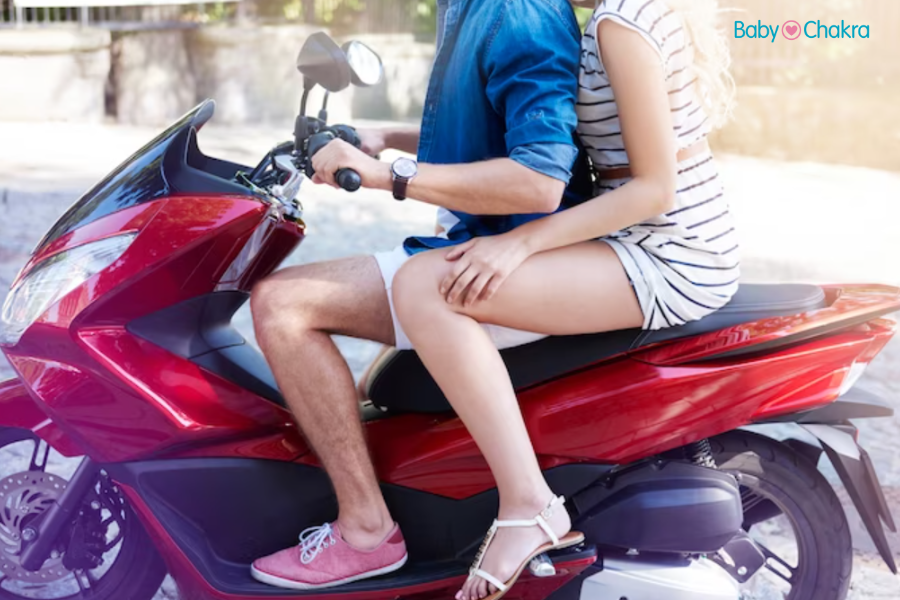
20 Mar 2023 | 4 min Read
Lack of Comfort
Riding a two-wheeler during pregnancy can be uncomfortable, especially during the later stages of pregnancy. The lack of proper support and cushioning can lead to back pain, hip pain, and discomfort.
How To Stay Safe While Travelling On Bike Or Scooter During Pregnancy
While travelling on a two-wheeler pregnant women need to make sure they sit with legs on each side of the seat to avoid bumps and jerks. If it is necessary for pregnant women to travel on a two-wheeler, they should follow some precautions to ensure their safety and that of their growing baby.
Here are some tips for safe two-wheeler travel during pregnancy:
- Wear Protective Gear: While wearing a helmet while driving a scooter or a bike is mandatory, during pregnancy women, need to be more careful and should always wear a helmet and other protective gear, such as gloves and knee pads, while travelling on a two-wheeler. This can help prevent injuries in case of an accident.
- Avoid Long Rides: Pregnant women should avoid long rides on a two-wheeler, particularly during the first and third trimesters of pregnancy. If it is necessary to travel on a two-wheeler, it is recommended to take frequent breaks and stretch.
- Choose a Comfortable Vehicle: During pregnancy, women should choose a comfortable two-wheeler that provides adequate support and cushioning. It is recommended to opt for a vehicle with a larger seat and backrest to reduce discomfort during travel.
- Avoid Polluted Areas: Pregnant women should avoid travelling through areas with high levels of pollution. It is recommended to take a different route or opt for public transportation.
- Take Assistance: Women should take assistance while boarding or getting off the two-wheeler and should avoid lifting heavy objects and straining themselves.
Consult a doctor before travelling on a two-wheeler. The doctor can evaluate the risks and advise on the precautions to be taken during the journey. Travelling on a two-wheeler during pregnancy can be risky and should be avoided as much as possible.
Pro Tip: Check out these natural skincare products that are safe to use during pregnancy:

The Moms Co.
What Are Antenatal Classes?: Read to know how these classes help expectant parents.
Managing Loose Motions During Pregnancy: Tips and precautions to follow

Related Topics for you
babychakraenglish
pregnancycare
pregnancymustknow
pregnancytips
Suggestions offered by doctors on BabyChakra are of advisory nature i.e., for educational and informational purposes only. Content posted on, created for, or compiled by BabyChakra is not intended or designed to replace your doctor's independent judgment about any symptom, condition, or the appropriateness or risks of a procedure or treatment for a given person.
Nervous About Bicycle Riding While Pregnant? Here’s the Information You Need
Your primary concern is safety, of course, so here is how to decide if cycling and pregnancy go together.

Gear-obsessed editors choose every product we review. We may earn commission if you buy from a link. How we test gear.
A few of my friends also rode through their pregnancies, while others stopped as soon as they started to show. Of course, some only did stationary cycling as soon as the plus sign appeared on the test stick.
Cyclist and mother Laura King decided to continue cycling while pregnant. During her 2019 pregnancy, she told Bicycling : “My cycling routine remains largely unchanged. I’m more discerning about the wheel that I follow, and I consider less trafficked roads and safe terrain.”
The American College of Obstetrics and Gynecologists rules out high-risk activities such as horseback riding and downhill skiing while pregnant, but it doesn’t single out cycling. It does note that off-road riding (which certainly means mountain biking, not riding on a path) can be risky, and that riding an indoor stationary bike is safer than cycling outside because of potential balance issues that may pop up as your belly grows.
“Common sense should rule,” Mary Jane Minkin, M.D. , clinical professor of obstetrics, gynecology, and reproductive services at Yale School of Medicine told Bicycling . “If you’re a good rider who has been riding for years and is comfortable on the bike, keep riding.”
Just pay close attention to how you feel once you get out of the first trimester or so. “Some women feel out of balance as their center of gravity changes,” Minkin says. “You don’t want to be on a bike if you feel off balance . It’s the same advice I give skiers. You don’t want to be falling, so use your head.”
That’s always good advice, of course, but it’s sometimes hard to do—especially when you’re wading into the often unpredictable waters of pregnancy. You will be bombarded with advice, whether you want it or not. You will second and third guess your every move. Total strangers will criticize you if they don’t like what you’re doing. So, here’s a guide on how to stay safe and smart if you choose to keep pedaling .
Keep in mind this article is not a substitute for medical advice. Every pregnancy is different, even within the same woman. There are high-risk pregnancies where riding (or any activity) may not be safe, so always consult with your doctor.

Keep It Moderate
When it comes to exercising during pregnancy, including cycling, the general advice is to keep doing what you were doing before you got pregnant. For an Ironman-level triathlete , that could be a two-hour bike ride. For someone just starting out, it might be a 30-minute ride.
During you pregnancy, you should stick with what you know; it’s not the time to try to break any records or push your limits. While doctors no longer set heart-rate limits (years ago, they put the ceiling at 140) but they do recommend that you keep your efforts moderate (i.e., you can still talk while you ride).
According to the American College of Sports Medicine’s Health and Fitness Journal , pregnant women should aim for 150 minutes or more of moderate exercise a week, and that exercise can actually lower the chances of complications during pregnancy. So, even if you don’t get on a bike outside, you should still exercise, unless your doctor tells you differently.
Take It Trimester by Trimester
Remember (again, but it bears repeating): Every pregnancy is different, and you’ll feel different throughout every pregnancy. In general, the first trimester includes a sea of change in hormones , as your body works overtime to establish the pregnancy and create the placenta. You may be plagued with morning sickness, fatigue , and a general “I just don’t feel like myself” feeling. Or you may feel pretty much fine.
Minkin recommends just using your head and also listening to your body and intuition when you are deciding whether to work out and how much to do.
“It can seem counterintuitive during the first trimester to get on the bike when you’re feeling tired and nauseous,” says King, “but I found the fresh air, movement, and routine to help curb my nausea and boost my energy levels for the day.
Usually that early malaise lifts as you go into the second trimester, and you get your energy back. This could be when you feel best on the bike. It might also be when you start to get bigger and your center of gravity changes, so stay in tune with how you feel.
Going into the third trimester can also set off your balance. I carried low and actually felt more stable in the saddle, though. But by eight months in, some of my friends felt so unwieldy that they couldn’t get on the bike again until their babies were born.
Always do what feels right for you and do not compare yourself to other women.
Give Yourself More Time ... and Space
It goes without saying that you’re going to be a little slower as your belly grows, and there’s less room for, oh, deep breathing . There’s a little person growing inside you, taking up some of that extra energy you’d be using for pedaling. Your usual loops will start to take longer, so plan accordingly, and shorten them as needed.
“Though weight gain makes me a bit slower uphill, and I take fewer risks on descents , I’m still able to challenge myself and work hard,” says King.

You’re going to be bigger and heavier physically, which impacts your bike handling. You will also need more time to slow down and to stop. You might find it trickier to corner . Bike paths, open roads, and rail trails can be your best friend during those final months.
Finesse Your Fit
As your bump gets bigger, you might have a harder time bending over the bars and may need a new bike fit to stay comfortable in the saddle. Raising your handlebars put you in a more upright position. Also, you will sit more heavily on the saddle , so you also may want to use a wider saddle like those on comfort bikes, which are designed to support your seat when you’re sitting more straight up.
“Make sure you have a good bike fit and a proper fitting saddle ! The pelvic floor undergoes many changes during pregnancy, and with new weight distribution and ligament laxity—due to the hormone relaxin—your fit may need tweaking throughout the nine months,” says King. “Many find a mountain bike to be helpful in the later months for added stability and a more comfortable upright position.”
Likewise, you will likely need to adjust your clothing selection. A larger pair of bib shorts or even a padded chamois liner for your favorite maternity shorts or tights should do the trick.
Pack Fluids and Food
Don’t underestimate your energy needs. I’ll never forget when I went out on a mostly flat 20-mile ride that I’d done a million times before with two of my friends, another of whom was also pregnant. I had eaten a good breakfast and hadn’t thought twice about heading out with them for a lunchtime spin.
About five miles from home, I hit the wall—and I only had two dollars in my pocket. I kept telling myself if I could just make it back to the edge of town, I could stop at the Pizza Hut (and I don’t even like Pizza Hut!) and buy whatever I could get for two dollars. I got a breadstick to get me home. Lesson learned: Pack extra food in your pockets.
It’s even more important to stay well-hydrated when you’re pregnant. Not only do you need more water for your body to perform all the usual functions, as well as those involved with pregnancy, but also it’s easier to overheat when you’re pregnant because your metabolic rate is higher and your body isn’t able to rid itself of heat as easily. Carry twice as much fluid as you normally would, and don’t ride in high heat .
Try the Trainer or Cross-Training
If riding becomes uncomfortable—physically or psychologically—don’t sweat it. You can easily maintain your fitness by hopping on a spin bike or setting yours up on a stationary trainer . In fact, Zwift has a training program specifically for pregnant cyclists called “ Baby on Board .”
But if that bores you, swim, hike, or dance. This is your time to take care of yourself as you like.
“While there’s risk in almost any activity, it’s worth considering how cycling can positively affect your mental state. Depression is common in many women during pregnancy and postpartum, so don’t discount the benefits that physical activity can add,” says King.
The same study cited earlier also found that regular moderate exercise during pregnancy can reduce a woman’s chance of getting depression by 67 percent, along with reducing the severity of any symptoms that do occur.

.css-1t6om3g:before{width:1.75rem;height:1.75rem;margin:0 0.625rem -0.125rem 0;content:'';display:inline-block;-webkit-background-size:1.25rem;background-size:1.25rem;background-color:#F8D811;color:#000;background-repeat:no-repeat;-webkit-background-position:center;background-position:center;}.loaded .css-1t6om3g:before{background-image:url(/_assets/design-tokens/bicycling/static/images/chevron-design-element.c42d609.svg);} Women's Cycling

What Happens When Anti-Doping Is Wrong?

Demi Vollering Conquers Vuelta a Burgos Féminas

Endurance Cycling Insights from Hannah Otto

Itzulia Women 2024: Route, How to Watch, Favorites
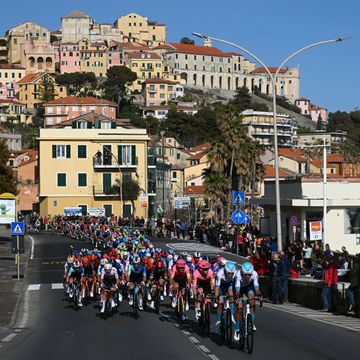
Giro Organizers Planning a Women’s Milano-Sanremo

Cycling’s Silent Epidemic

Demi Vollering Inks Major Deal with Nike

Vos and MvdP: Top Earners of the Spring Classics

Demi Vollering’s Future Remains Uncertain

How to Watch La Vuelta Femenina 2024

Kopecky Won’t Be Racing the Tour de France Femmes
- Weight Management
- Nutrition Facts
- Nutrition Basics
- Meal Delivery Services
- Fitness Gear
- Apparel & Accessories
- Recipe Nutrition Calculator
- Weight Loss Calorie Goal
- BMI Calculator
- Body Fat Percentage Calculator
- Calories Burned by Activity
- Daily Calories Burned
- Pace Calculator
- Editorial Process
- Meet Our Review Board
Indoor Cycling During Pregnancy
Stacey Colino is a certified spinning instructor and group exercise instructor through the Aerobics and Fitness Association of America (AFAA).
:max_bytes(150000):strip_icc():format(webp)/Stacey-Colino-1000-822aefa613544f4bacf3e4cca95f6c68.jpg)
Cara Lustik is a fact-checker and copywriter with more than 15 years of experience crafting stories in the branding, licensing, and entertainment industries.
:max_bytes(150000):strip_icc():format(webp)/Cara-Lustik-1000-8eb5718d7cd34f8797e1ffa65d7f3e7a.jpg)
miljko / Getty Images
You’ve probably heard that exercising during pregnancy is good for both the parent-to-be and the baby. After all, staying physically active while you’re pregnant can enhance blood circulation, ease backaches, improve digestion and sleep, boost your mood and energy, help manage weight gain, and promote muscle tone, strength, and endurance (all of which you’ll need for childbirth).
The American College of Obstetricians and Gynecologists (ACOG) advises pregnant people to exercise often during pregnancy, especially those who were physically active prior to becoming pregnant. In addition, the guidelines indicate that people who regularly engaged in vigorous-intensity aerobic exercise prior to pregnancy may continue these activities during their pregnancy.
According to ACOG, observational studies of pregnant people who exercise show benefits such as reduced risk of gestational diabetes mellitus, cesarean birth, and operative vaginal delivery as well as reduced postpartum recovery time. Exercise can also be helpful in preventing postpartum depression.
Stationary cycling has been "extensively studied in pregnancy and found to be safe and beneficial," ACOG states. Still, it’s important to exercise wisely during the nine-month stretch, especially to accommodate your changing body—not only the extra pounds you’re toting around, but also your increasingly relaxed ligaments, the shift in your center of gravity, and so on.
Cycling Safety During Pregnancy
Indoor cycling is ideal because you won’t confront balance challenges or have a heavy impact on your joints. Whether you choose spin classes like SoulCycle or Flywheel or on-demand classes like Peloton, there are many types of indoor cycling workouts to try.
Compared to outdoor cycling, indoor cycling is safer during pregnancy. Outdoor cycling is not recommended because of the risk of falls and other dangers, such as traffic and weather conditions.
Although indoor cycling is generally considered safe during pregnancy, you should still get the green light from your OB/GYN in case you have any underlying medical conditions that might limit your activity options.
Peloton While Pregnant
Taking Peloton or other cycling classes during pregnancy is safe—as long as a healthcare provider does not have any concerns. It’s important to take certain precautions. For starters, remember that you are essentially exercising for two, which means it’s easier for your heart rate to elevate more quickly and for you to become overheated. Take it easier on the bike than you would if you weren’t pregnant.
Also, keep in mind that it’s best to continue with any exercise you were doing pre-pregnancy versus starting a new routine. Here are some other helpful tips for having a safe ride.
Talk to the Instructor Beforehand
It's a good idea to seek out an instructor who has some training in prenatal exercise. Whether or not you’re showing yet, tell the instructor that you’re pregnant before the class starts. This way, they can keep an eye on how you're doing and won’t push you too hard.
Your instructor can also give you important pointers on how to modify the ride to suit your needs. You may benefit from sticking with the same instructor whenever you can so they can get to know you and are familiar with your modifications and needs.
Stay Cool and Well Hydrated
Wear comfortable, breathable clothing that will help you stay cool and a bra that offers plenty of support. Drink lots of water throughout the workout—even more than usual.
Note that both overheating and dehydration are common during pregnancy and can be dangerous for both parent and baby. Since you're carrying an extra 20 to 30 pounds and have 40% more blood pumping through your body toward the end of pregnancy, you are also likely to sweat more and can easily become dehydrated. If your bike has no built-in fan, getting a fan for home gyms is highly recommended.
Modify Your Bike Set-Up
As your pregnant body continues to change, you may need to adjust the saddle position and raise the handlebars on your bike to stay comfortable. It’s a good idea to sit more upright (which means raising the handlebars and bringing them closer to you), instead of leaning forward, to relieve strain on your lower back.
Another goal is to keep your weight more evenly distributed between your hands and body. Also, avoid moveable indoor bikes that mimic outdoor riding. They can lean sideways, which might cause a fall.
Dial Down Your Intensity
During pregnancy, it’s best to exercise at a moderate intensity, especially during indoor cycling. To make sure you stay at a safe intensity, consider wearing a heart rate monitor .
It’s also helpful to pay attention to the Rating of Perceived Exertion Scale (RPE) . Even if your heart rate isn’t too high, if you’re gasping for breath or feeling lightheaded, you should slow down or stop exercising immediately.
The guidelines from ACOG indicate that 13-14 ("somewhat hard") on the Borg RPE scale is a safe and acceptable level of exertion. The guidelines also state that RPE is a better gauge of exertion than heart rate and that the " talk test " can be another good indicator of safe workout intensity. In other words, you should be able to hold a conversation while you're exercising.
Stay in the Saddle
During the early months of pregnancy, you may be able to ride in a standing position without any problems. But as your growing belly changes your body’s center of gravity it puts more pressure on your joints, which can make it difficult to ride standing. Don’t worry: You can still get a good workout if you stay seated the whole time—and most importantly, you’ll avoid overdoing it or injuring yourself.
Joints are looser or more flexible during pregnancy, which makes standing while cycling more difficult and risky.
Heed Your Body's Signals
Listening to your body while you're exercising is crucial, but it is especially important while you’re pregnant. If you get winded, dizzy, or don’t feel well while you're riding, take a break or take your effort down a few notches.
And if a 45- or 60-minute class is too intense for you, feel free to depart early (just let the instructor know you’re OK). During pregnancy, your energy is likely to ebb and flow, so pay attention to your body's signals and take care of it accordingly.
Stop exercising if you experience any of the following warning signs:
- Abdominal pain
- Amniotic fluid leakage
- Calf pain or swelling
- Dyspnea (shortness of breath) before exertion
- Muscle weakness affecting balance
- Regular painful contractions
- Vaginal bleeding
Call your doctor if you experience any sharp pain, contractions, a gush of fluid, sudden severe headache, prolonged swelling, or if you notice a decrease in movement from the baby.
Riding a Stationary Bike While Pregnant
If you're interested in cycling classes but have not taken them before, you might prefer to start on your own on a stationary bike to build endurance before trying a group class. Compared to other cardio machines at the gym, the stationary bike provides a personalized low-impact workout. You get to control the intensity and the duration of your ride.
In some cases, a recumbent bike might be more comfortable, especially later in pregnancy, since it provides back support. Just keep in mind that you don't want to lean back too far.
A Word From Verywell
Exercise that includes indoor cycling during pregnancy is generally safe and recommended by experts. Just be sure to monitor your heart rate and/or RPE to make sure you don't overdo it. As a general rule, you should be able to maintain a conversation while you're working out. The best type of exercise is the one you enjoy and will stick with throughout your pregnancy.
Hinman SK, Smith KB, Quillen DM, Smith MS. Exercise in pregnancy: A clinical review . Sports Health . 2015;7(6):527–531. doi:10.1177/1941738115599358
The American College of Obstetricians and Gynecologists. Exercise during pregnancy .
Physical activity and exercise during pregnancy and the postpartum period: ACOG Committee Opinion, Number 804 . Obstet Gynecol . 2020;135(4):e178-e188. doi:10.1097/AOG.0000000000003772
By Stacey Colino, AFAA-GFI Stacey Colino is a certified spinning instructor and group exercise instructor through the Aerobics and Fitness Association of America (AFAA).
- Getting Pregnant
- Registry Builder
- Baby Products
- Birth Clubs
- See all in Community
- Ovulation Calculator
- How To Get Pregnant
- How To Get Pregnant Fast
- Ovulation Discharge
- Implantation Bleeding
- Ovulation Symptoms
- Pregnancy Symptoms
- Am I Pregnant?
- Pregnancy Tests
- See all in Getting Pregnant
- Due Date Calculator
- Pregnancy Week by Week
- Pregnant Sex
- Weight Gain Tracker
- Signs of Labor
- Morning Sickness
- COVID Vaccine and Pregnancy
- Fetal Weight Chart
- Fetal Development
- Pregnancy Discharge
- Find Out Baby Gender
- Chinese Gender Predictor
- See all in Pregnancy
- Baby Name Generator
- Top Baby Names 2023
- Top Baby Names 2024
- How to Pick a Baby Name
- Most Popular Baby Names
- Baby Names by Letter
- Gender Neutral Names
- Unique Boy Names
- Unique Girl Names
- Top baby names by year
- See all in Baby Names
- Baby Development
- Baby Feeding Guide
- Newborn Sleep
- When Babies Roll Over
- First-Year Baby Costs Calculator
- Postpartum Health
- Baby Poop Chart
- See all in Baby
- Average Weight & Height
- Autism Signs
- Child Growth Chart
- Night Terrors
- Moving from Crib to Bed
- Toddler Feeding Guide
- Potty Training
- Bathing and Grooming
- See all in Toddler
- Height Predictor
- Potty Training: Boys
- Potty training: Girls
- How Much Sleep? (Ages 3+)
- Ready for Preschool?
- Thumb-Sucking
- Gross Motor Skills
- Napping (Ages 2 to 3)
- See all in Child
- Photos: Rashes & Skin Conditions
- Symptom Checker
- Vaccine Scheduler
- Reducing a Fever
- Acetaminophen Dosage Chart
- Constipation in Babies
- Ear Infection Symptoms
- Head Lice 101
- See all in Health
- Second Pregnancy
- Daycare Costs
- Family Finance
- Stay-At-Home Parents
- Breastfeeding Positions
- See all in Family
- Baby Sleep Training
- Preparing For Baby
- My Custom Checklist
- My Registries
- Take the Quiz
- Best Baby Products
- Best Breast Pump
- Best Convertible Car Seat
- Best Infant Car Seat
- Best Baby Bottle
- Best Baby Monitor
- Best Stroller
- Best Diapers
- Best Baby Carrier
- Best Diaper Bag
- Best Highchair
- See all in Baby Products
- Why Pregnant Belly Feels Tight
- Early Signs of Twins
- Teas During Pregnancy
- Baby Head Circumference Chart
- How Many Months Pregnant Am I
- What is a Rainbow Baby
- Braxton Hicks Contractions
- HCG Levels By Week
- When to Take a Pregnancy Test
- Am I Pregnant
- Why is Poop Green
- Can Pregnant Women Eat Shrimp
- Insemination
- UTI During Pregnancy
- Vitamin D Drops
- Best Baby Forumla
- Postpartum Depression
- Low Progesterone During Pregnancy
- Baby Shower
- Baby Shower Games
Traveling while pregnant: Your complete guide
Unless you're nearing your due date or have certain complications, your healthcare provider will generally give you the green light for pregnancy travel. Here's how to safely explore – plus what to consider before making plans.

Is traveling while pregnant safe?
When to avoid pregnancy travel, when is the best time to travel while you're pregnant , can pregnant women travel during covid, when should you stop traveling while pregnant, your pregnancy travel checklist, when to call your doctor while traveling.
Yes, it's generally safe to travel during pregnancy as long as you're not too close to your due date and you're not experiencing any serious pregnancy complications. There are special precautions to take, of course, and you may find yourself stopping to use the bathroom more than you're used to, but that babymoon can be within reach.
Before you pack your suitcase, talk with your healthcare provider to make sure it’s safe for you to travel and that your destination is a good choice. You'll want to avoid places where infectious diseases are prevalent (or there are high outbreaks of Zika or malaria, for example). The COVID-19 pandemic has made people reconsider where they feel safe traveling as well; if you're fully vaccinated, the CDC says you can travel Opens a new window , but it's always best to check with your doctor first.
And bear in mind that the activities you take part in might be different than normal – you'll want to skip the Scuba diving lessons, for example (though snorkeling is okay!).
It's safe to fly when you're pregnant as well, and most airlines will allow you to fly domestically until about 36 weeks of pregnancy. International routes may have different rules, so be sure to check with your airline before booking anything. Your doctor will tell you to avoid flying, however, if you have a health concern that might require emergency care or any other health conditions that aren’t well controlled.
It's best to avoid traveling while pregnant if you have any health conditions that can be life-threatening to both you or your baby. If you have any of the following conditions, your doctor will almost certainly advise you against travel:
- Placental abruption
- Preeclampsia
- You're in preterm or active labor
- Cervical insufficiency (incompetent cervix)
- Premature rupture of membranes (PROM)
- A suspected ectopic pregnancy
- Vaginal bleeding
You might also need to be extra-cautious or skip travel if you're experiencing intrauterine growth restriction , you have placenta previa , or you have other conditions that may place your pregnancy at a higher risk. It’s always a good idea to discuss your concerns with your healthcare provider before travel regarding any medical conditions you have, and they'll be able to advise you on what's best, depending on the trip.
The sweet spot for pregnancy travel is during your second trimester , between 14 weeks and 27 weeks. By the second trimester, any struggles you’ve had with morning sickness and fatigue during the earlier weeks of pregnancy should have hopefully subsided – and after 12 weeks, your risk of miscarriage decreases significantly as well. And you're not too far along to worry about third trimester exhaustion or going into preterm labor yet, either.
Your energy levels are likely to be good during your second trimester too (bring on the sightseeing!), and it will still be relatively easy and comfortable for you to travel and move around at this time. Keep in mind that once you hit that third trimester, pregnancy travel might be more difficult as you find it harder to move around and stay still for long periods of time.
It's complicated (and often a personal decision based on your own risk factors), but the CDC says that if you're fully vaccinated against COVID-19, you can travel. Of course, it's important you still do everything you can to keep yourself and others around you safe, including following all mask-wearing and social distancing guidelines in the destination you visit.
Women are at an increased risk for severe illness if they contract COVID-19 while pregnant , and they're more likely to experience preterm birth and other poor pregnancy outcomes. (This is why the CDC, the American College of Obstetricians and Gynecologists, and the Society for Maternal-Fetal Medicine all recommend that women who are pregnant, breastfeeding, or are planning on becoming pregnant get the COVID vaccine .)
If you're vaccinated and decide to travel, the CDC advises avoiding international destinations that are designated Level 4, due to high rates of local COVID-19 transmission.
Take all this information into account and talk to your doctor before you decide on where and when to travel while you're pregnant. And if you experience any symptoms of COVID-19, whether while traveling or at home, call your healthcare provider as soon as possible.
The guidelines for when to stop traveling while you're pregnant vary based on your mode of travel, but more or less, you should wrap up travel before you're 36 weeks pregnant.
Most airlines will let pregnant women fly domestically until they're 36 weeks pregnant – and many cut that off earlier for international travel. This rule is often enforced on an honor system policy, but some airlines may ask for a doctor’s note – so make sure you have that from your healthcare provider if you're traveling in the third trimester, just in case.
Most cruise ships don't allow travel after 24 weeks of pregnancy. Some cruise lines' cutoff dates vary, so verify policies before booking a cruise.
As for road trips, there's no official deadline for when you need to stop traveling, but your personal comfort level (physically and emotionally) – and your doctor's advice – might help you decide. You can drive while pregnant all the way up until your due date, but things may get considerably less comfortable on longer trips as you approach full term.
Travel of any kind requires advance preparation, but when you're pregnant and traveling, that pre-trip checklist gets a little longer. Give yourself a little more time than usual to plan for a trip – and use the tips below to stay safe and comfortable on your next adventure.
Before you travel
- Talk to your healthcare provider to determine if your trip is safe for you and if there are any medical concerns to consider. It's a good idea to discuss any activities you plan to do while you're away too. If you're planning an international trip, make sure to ask about any vaccines you may need for the areas you're visiting.
- Make sure you know your prenatal test schedule. Plan travels around any prenatal tests you need to schedule, including ultrasounds and other important screening tests.
- Book an aisle seat. You'll likely be more comfortable being able to get up to stretch or go to the bathroom on longer flights.
- Buy travel insurance. You don't need special travel insurance when you're pregnant, but it's never a bad idea to secure a policy. You may want to consider one with a “cancel for any reason” clause that reimburses you for money lost on cancelled trips for reasons (read: any reason) beyond what’s listed on the base policy. Check with your personal health insurance, too, to make sure it covers potential pregnancy complications while traveling internationally (some don’t). Consider adding evacuation insurance as part of a travel insurance plan, too.
- Gather your medical records and health information . If you’re in your second or third trimester, ask your ob-gyn or midwife for a digital copy of your prenatal chart, and have that easily accessible during your trip. Typically, this chart includes your age, your blood type, the name and contact information for your healthcare provider, the date of your last menstrual period, your due date, information about any prior pregnancies, your risk factors for disease, results of pregnancy-related lab tests (including ultrasounds or other imaging tests), your medical and surgical history, and a record of vital signs taken at each visit.
- Keep a list of key names and numbers you may need in the event of an emergency saved on your phone and written on a piece of paper (in case your battery dies).
- Have a contingency plan for doctors and hospitals that will take your insurance where you're going in case you go into labor early or experience pregnancy complications that require urgent care while you're away from home.
- Pack medicines and prenatal vitamins. That might include an extended supply of prescriptions and over-the-counter remedies , too. Bring enough to cover your entire trip and a written prescription that you can fill if you lose anything. It's a good idea to keep prescription medicine in its original container, so if your bags are searched it will be clear that you're not using medication without a prescription.
- Prepare for the unexpected. On a road trip, that might mean an unexpected breakdown, so join an auto club that provides roadside assistance. Download any apps you use for renting cars and accessing boarding passes before you leave so you can easily reschedule things in the event of a last-minute cancellation.
- If you're flying during your third trimester, be sure to call the airline to check about the cutoff week for pregnancy travel. A note from your doctor that says you’re cleared to travel is always good to have when traveling during your third trimester.
During your trip
- Drink plenty of water and continue to eat healthy foods . Keep in mind that many restaurants abroad commonly serve unpasteurized foods (like soft cheeses and milk), which can be dangerous for pregnant women due to the presence of listeria.
- Avoid eating raw or undercooked meat or fish , drinks with ice (which may be contaminated), non-bottled water, and other foods that can cause traveler's diarrhea, which can be more of a problem for pregnant women than other people.
- On long flights and drives, take time to stretch by pulling over for a walk or strolling up and down the airplane aisle. And when seated, always wear your seat belt .
- Maternity compression socks are handy to have along – both in transit and worn under your clothes while you’re out and about exploring – because they can ease the symptoms of swollen feet and legs. These are a few of our favorite pregnancy compression socks .
- Take advantage of help. Many countries have dedicated lines in shops and airports for pregnant travelers, so don't feel any shame taking a shorter wait if you see one.
- Go easy on yourself. Remember, you're growing a baby. You might not have quite the stamina for sightseeing and late nights like you used to pre-pregnancy. Make the most of your vacation but don't fret you miss out on things because you need more downtime from exploring than you usually would.
- Don’t forget to get photos of your bump. When your baby is older, you'll have fun showing them all the places you traveled with them before they were born.
- Go for the comfy shoes. Travel during pregnancy is the best reason ever to forgo those strappy stilettos for your favorite sneakers .
- Pack snacks so you always have something to curb your appetite if there’s a long wait for a restaurant or you get stuck in transit or someplace remote with no food offerings.
- Try to be in the moment with your travel partners as much as possible. Once your baby is born, your attention will be pulled in a whole new direction.
If you have any medical concerns traveling while pregnant, don’t hesitate to pick up the phone and call your doctor for advice. The below are a few symptoms that definitely warrant calling your ob-gyn or health care provider or seeking emergency care while traveling or at home:
- Signs of pre-term labor (including a constant, low dull backache, bleeding, etc.)
- Ruptured membranes (your water breaks)
- Severe cramping
- Spiking blood pressure
- Severe nausea or vomiting
- COVID-19 symptoms
Was this article helpful?
Best compression socks for pregnancy

Is it safe to fly while I'm pregnant?

Is it safe to travel to high altitudes while pregnant?

How to plan the best babymoon so you can relax before your baby comes

BabyCenter's editorial team is committed to providing the most helpful and trustworthy pregnancy and parenting information in the world. When creating and updating content, we rely on credible sources: respected health organizations, professional groups of doctors and other experts, and published studies in peer-reviewed journals. We believe you should always know the source of the information you're seeing. Learn more about our editorial and medical review policies .
AAFP. 2020. Ultrasound during pregnancy. American Academy of Family Physicians. https://familydoctor.org/ultrasound-during-pregnancy/ Opens a new window [Accessed April 2023]
ACOG. 2020. FAQ055: Travel during pregnancy. American College of Obstetricians and Gynecologists. https://www.acog.org/womens-health/faqs/travel-during-pregnancy Opens a new window [Accessed April 2023]
CDC. 2019. Pregnant Travelers. https://wwwnc.cdc.gov/travel/yellowbook/2020/family-travel/pregnant-travelers Opens a new window [Accessed April 2023]
CDC. 2022. Domestic Travel During Covid-19. https://www.cdc.gov/coronavirus/2019-ncov/travelers/travel-during-covid19.html Opens a new window [Accessed April 2023]
CDC 2023. International Travel During Covid-19. https://www.cdc.gov/coronavirus/2019-ncov/travelers/international-travel-during-covid19.html Opens a new window [Accessed April 2023]
CDC. 2022. Covid-19: Pregnant and Recently Pregnant People. https://www.cdc.gov/coronavirus/2019-ncov/need-extra-precautions/pregnant-people.html Opens a new window [Accessed April 2023]

Terry Ward is a freelance travel, health, and parenting writer who has covered everything from flying with toddlers to why you should travel with your kids even when they're too young to remember it. She lives in Tampa, Florida, with her husband and their young son and daughter, and enjoys camping, sailing, scuba diving, skiing, and almost anything else done in the great outdoors.
Where to go next

Bike Station Blog
Is it Safe to Ride a Bike When Pregnant?
- Post author By Tom
- Post date December 27, 2021
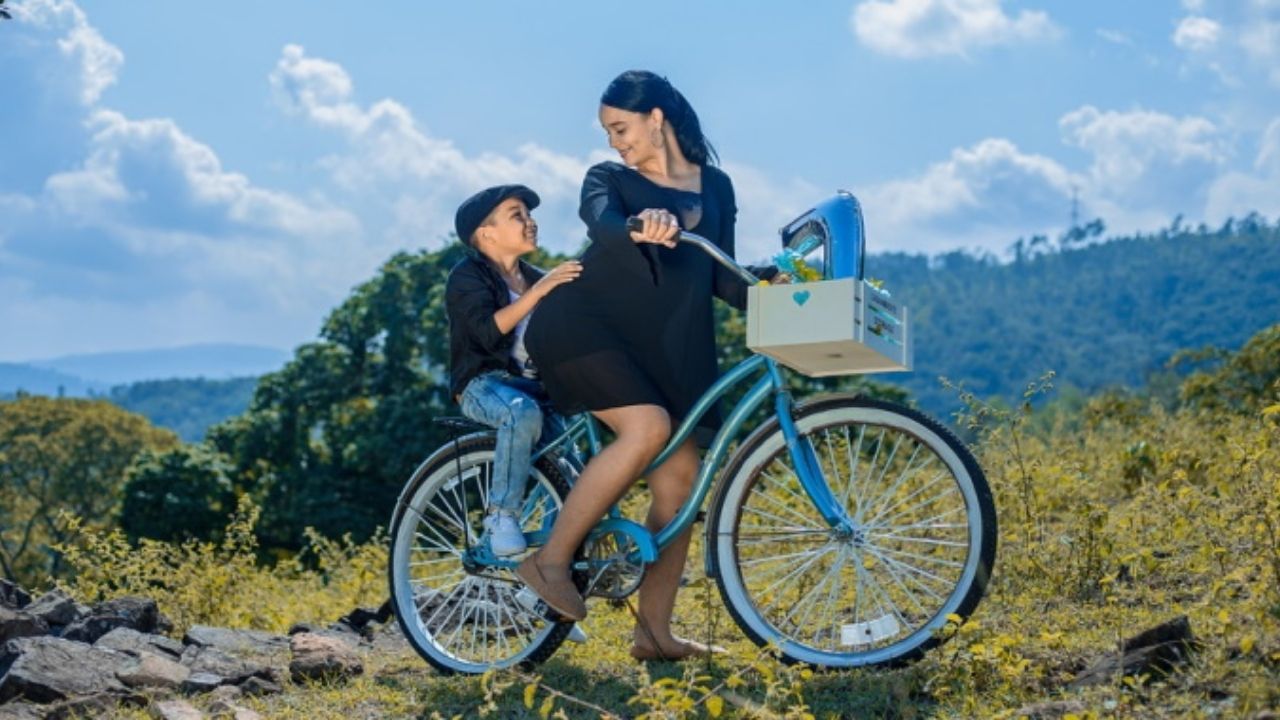
Are you a fan of cycling, but worry cruising on your bike might hurt your unborn child? You’ll be happy to know most doctors agree that riding a bike isn’t dangerous during pregnancy. In fact, it can help keep you physically and mentally healthy, something which is good for you and your baby.
According to the American College of Obstetricians and Gynecologists, cycling is a great form of aerobic exercise that improves mood, sleep, and posture. All of these will aid your baby’s growth and can help ease pregnancy and labor.
To unlock the benefits of cycling while pregnant, it’s important to adhere to certain practices or risk hurting yourself and your baby. Some of these best practices include:
Page Contents
Taking it Easy
Placing unnecessary strain on your body when pregnant is no good for you or your baby. As the pregnancy progresses, your body will change and may not be able to handle as much strain and stress. As such, instead of trying to break new speed or distance records, take things easier, especially when your body starts warning you it’s time to stop.
For example, nausea, pain, or exhaustion are signs to slow down or stop. Ignoring such signs could endanger you and your baby. A simple test for determining whether you are overdoing it is holding a conversation while cycling. If you struggle to catch your breath while cycling and talking, slow down.
Staying Hydrated
Normal weight gain during pregnancy means you’ll burn more energy, leading to more sweating. As your body loses fluids, you’ll need to replace them by staying hydrated, especially if you are cycling or performing other exercises.
Frequent dehydration during pregnancy can lead to complications, such as low breast milk production, neural tube defects, premature labor, and birth defects. Take enough drinking water or other fluids with you on your cycling trip.
Choose the Right-Sized Bike
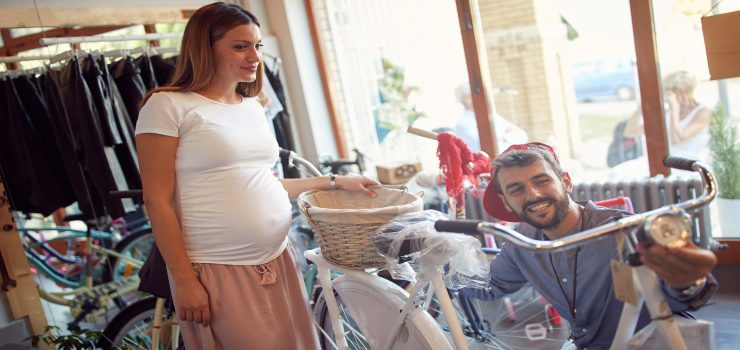
As your pregnancy bump grows bigger, your regular bike may no longer be the right size for you . For example, a growing baby bump makes it harder to bend over the handlebars. If you can adjust the saddle and handlebar of your bike to accommodate your needs, that’s fine. You may find that you need to raise the handlebars to help you stay in an upright position.
If during pregnancy you require a new bike to accommodate changes, go for one with swept-back handlebars and a wider adjustable seat. Using a bike that’s too small can affect your balance, giving you less control and a greater chance of falling and hurting yourself or your child.
Stretchy or Loose-Fitting Clothing
If you are wearing loose-fitting clothing, it shouldn’t be so loose it ends up caught in the bike chain, pedal, or tires. Stretchy clothing, like large bib shorts, are ideal because they offer a comfortable fit without stifling you or restricting your range of motion. For optimal comfort, check to make sure your undergarments are also comfortable for riding.

Take Fewer Risks
If you typically prefer cycling on bumpy, steep trails, or busy streets, find easier routes. As the pregnancy progresses, you might find navigating sharp turns or making sudden stops more difficult. That’s because a change in weight will affect your center of gravity and response time, causing the need to adjust when taking corners or dodging sudden traffic.
Stay safe by taking more leisurely routes, such as quiet open roads, rail trails, and so on.

Pregnancy requires your body to burn more energy to move. During your first trimester, you’ll need at least 1,800 calories per day. By your third trimester, you’ll need at least 2,400 calories per day. If you are cycling, you need to refuel properly by eating well and at the right time.
To be safe, take extra food with you when cycling. That ensures you’ll have something to snack on if hunger pangs suddenly; but remember that the quality of what you eat is more important than the quantity. Instead of prioritizing junk food, try to eat as healthy as possible as often as possible.
Get Enough Rest
Exercising is great for you and the baby, but so is lots of rest. By the third trimester, stay off your feet as often as you can. If getting on the bike feels wrong, listen to your body and don’t force it.
Everyone experiences pregnancy a little differently. Just because your neighbor kept biking until the day she went into labor doesn’t mean it’s right for your body. Have realistic expectations and pay attention to what your body tells you.
If you are passionate about cycling but don’t feel riding on the streets is the safest option, consider buying a stationary bike. It may not be as exhilarating or satisfying as biking outside, but at you’ll still get the quality exercise you need.
- Is It Safe to Ride a Bicycle While You’re Pregnant? – The Bump
- Is Cycling While Pregnant Safe? – Bicycling
- Baby on Board: 10 Tips for Riding While Pregnant – PeopleForBikes
- Categories Categories: Guides & Information
Be the first to hear about bike news!
I agree to receive emails from Bike Station.
What to expect when traveling in each trimester of pregnancy

So you're pregnant? Congrats! It's an exciting time but also one in which many aspects of your life will begin to change, including travel. While you'll quickly need to understand the airline industry's rules for flying while pregnant , there are some more personal tips I'd like to share with you based on my experience traveling throughout the first, second and third trimesters of both of my pregnancies.
A few truths about pregnancy
Picky, starving moms need to travel with snacks.
I didn't know I was pregnant when I took the first flight of my second pregnancy. I was on a mileage run from Houston to Los Angeles, and by the time we landed, I was super tired, kinda grumpy and oh-my-so-hungry.
Then began a mad search for food. Luckily, Counter Burger was open and serving up sweet potato fries and burgers. Out of habit, I went for the veggie burger but I quickly regretted my decision, which left me far from satisfied with ground-up veggie mush.
In the early stages of pregnancy, your normal travel habits of going a little hungry for a while, or making due with what's around, may not work well.
Throughout your pregnancy, travel with water to stay hydrated and snacks to stave off hunger pangs and keep you going through travel delays. If you're feeling particularly food sensitive, research the food options at your destination ahead of time. I virtually lived on chicken noodle soup for a whole week early in my pregnancy and then, for a couple of days, all I wanted were hush puppies. I know how to get those items at home but when you are on the road, you either need to do more research or be more flexible -- which is sometimes easier said than done.
Related: 4 tips for planning travel while planning a pregnancy
Research and make choices about inflight radiation and other risks
I'm not an expert, but because I fly often, I have given some thought to inflight radiation exposure , especially during the early stages of pregnancy.
For pregnant flight attendants and pilots, the Federal Aviation Administration recommends a limit of 1 mSv during pregnancy, with no more than 0.5 mSv per month. I don't fly as much as an airline employee, but it doesn't take much research to learn that the amount of radiation you (and your gestating baby) are exposed to in the air varies dramatically from route to route. The highest-level routes are typically longer, higher-altitude polar routes. Here's some information from NASA about polar flights and radiation .
Every expectant mother should discuss the risks of flying during pregnancy with her doctor before getting on a plane. For me, nine months was a tiny moment in my traveling life, so I was OK adjusting my behavior a bit out of an abundance of caution. However, I didn't adjust to the point of never leaving my house. We still flew when I was pregnant, but I was judicious about when and where I would fly.
Check your health insurance policy
If you aren't familiar with your medical insurance coverage for when you travel, brush up on those facts now. Look at in-network and out-of-network benefits, as well as coverage for procedures for medical emergencies in other countries, if relevant. Most likely, if you do have coverage for treatment in other countries, you will still be on the hook to pay for your care up front and then submit for reimbursement from your health insurer. Plan accordingly and plan for the unexpected. If your baby decides to arrive early, for instance, check to make sure your insurance would cover possible extended and expensive care in an intensive care unit in a hospital away from your home.
Be sure to check what your health insurance coverage provides if you deliver at another facility later in your pregnancy. I once had an insurance plan that specifically did not cover out-of-network deliveries after 36 weeks, so that is something you would want to know before venturing away from home late in pregnancy.
Consider travel insurance
Trip insurance can be helpful if you are traveling while pregnant. Read the plan's fine print to determine what might be covered and whether you are covered if you already knew you were pregnant when you purchased the plan. Typically, a normal pregnancy or normal delivery would not be covered but if there are unexpected complications with the pregnancy, then related trip-cancellation or trip-interruption coverage may kick in on certain plans in certain situations.
Here are some travel insurance providers to check out: Allianz Travel Insurance, Travel Guard and Travelex Insurance . You can also compare a variety of plans at a portal like SquareMouth .
Here are some articles that will help you brush up on your travel insurance knowledge:
- The best travel insurance policies and providers
- What is independent travel insurance and when is it worth it?
- When to buy travel insurance versus when to rely on credit card protections
- Is credit card travel insurance sufficient on its own?
- Why I buy travel insurance
Traveling in the first trimester
Traveling in the first trimester can range from "no big deal" to "I think I'm going to die from misery right this very instant." Symptoms in early pregnancy can vary widely and can change by the day. A flight in your first trimester may be no different from any other flight you've ever taken or it may feel like you are flying with the worst hangover of your life.
Unless you are very high risk or have other extenuating medical issues, your doctor will probably give you the green light to travel in early pregnancy. Feeling extra tired, nauseous and queasy doesn't make for the perfect travel experience, so here are some tips to make travel easier:
Pick an aisle seat and move about the cabin
When you do hit the skies early on, choose a seat where you will be the most comfortable, likely an aisle seat so you can get to the restroom easily. I also recommend getting up to walk around and stretch your legs. (Here are tips for credit cards that will defeat basic economy and let you get a seat assignment in advance.)
Room service come to the rescue
In my first trimester of my second pregnancy, I went on a trip with my daughter and parents to New York City to see the Macy's Thanksgiving Day Parade and I was met with another challenge. I was at the point in my pregnancy when I needed food immediately upon waking or I was going to get queasy. Since I was staying in a hotel room with my young daughter, this meant room service. I also had granola bars and fruit on hand, but that was not enough to really do the trick some mornings. Had my husband been there, he could have gone in search of a warm bagel and juice, but since he wasn't on this trip, we had to improvise. Thanks goodness Marriott elite status helped defray the cost of most of the breakfast!

Take it easy when you need to
Once you are further along in your pregnancy and you actually look pregnant, you will sometimes get a little sympathy or, at least, empathy while traveling. Strangers may offer to help with your bag and people may have more patience with you if you're moving slowly. However, in the first trimester nobody can tell you are pregnant, and no one is going to feel sorry for you. If you act queasy on the plane, you will pretty much be treated like you have Ebola, and any other issue or ailment will pretty much not interest anyone. I once told the flight attendant I was pregnant when she was giving me the eye about looking queasy.
Take care of yourself, don't overdo it and know when to say enough is enough. You may be used to very busy travel days, but now find yourself needing a nap during your first trimester, and that's OK. Listen to your body and adjust accordingly.
Traveling in the second trimester
You have probably heard that the second trimester is generally the easiest of the three trimesters for most expecting moms. You usually aren't as sick and or as tired as in the first trimester, and you aren't as large, uncomfortable and exhausted as in the third trimester. From roughly weeks 13 to 27 of a pregnancy, your activity and comfort levels are often good, and this means that it can be a great time to travel. Couples that like to take "babymoons" (one last couples trip before the baby arrives) often try to schedule them in the second trimester.
Related: The best babymoon destinations for every month of the year
The beginning and end of the second trimester are quite different
You will probably enter the second trimester not really looking pregnant, and end it looking quite different. This means that you may feel very different at the beginning and end of the second trimester. The second trimester is when lots of belly growing happens and this can mean that some types of travel will be more uncomfortable toward the end of these few months of pregnancy than at the beginning.
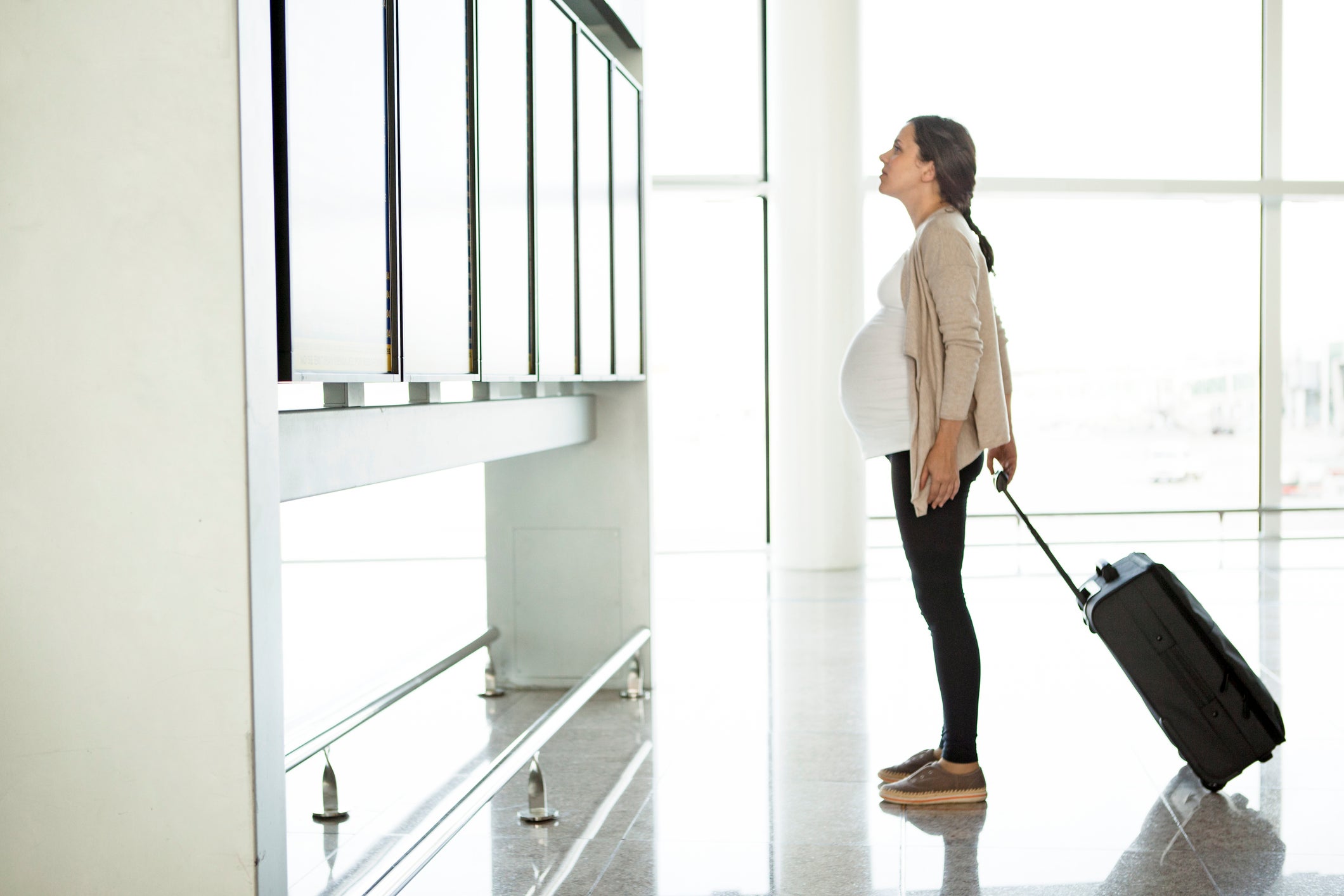
Consider where you are comfortable traveling
A very personal and important decision to make during the second trimester is to determine if there are certain restrictions you will place on yourself in terms of where you're comfortable traveling. Some types of travel will ban women from traveling during the second trimester. For example, many cruise lines will not allow a woman to book a cruise if she will enter her 24th week of pregnancy (or later) while on the voyage.
Royal Caribbean's policy bars pregnant women from sailing at and after the 24th week. It was developed in concert with the Cruise Lines International Association endorsement of the American College of Emergency Physicians Health Care Guidelines for Cruise Ship Medical Facilities .
Many consider unborn fetuses to be viable if born beginning around 24 weeks (though that age threshold is getting earlier and earlier). This means that a baby born at 24 weeks gestation would have anywhere from a 50% to 70% chance of survival outside the womb if (and only if) there is immediate access to advanced medical care. A cruise ship clearly doesn't have an advanced neonatal care unit on board, so presumably the policy is related to why cruise lines draw the line for pregnant passengers.
I personally draw the line for travel at 23 or 24 weeks when talking about destinations that don't have the same level of advanced medical care as the United States -- or long flights or a flight path that could hinder prompt access to advanced medical care if I happened to unexpectedly go into labor. The Maldives is an example of somewhere I would not want to travel in this instance because there would be significant delays in obtaining medical care on these remote islands.
Plan big, but not too big
The second trimester is a great time to squeeze in a pre-baby trip or two since you will probably feel relatively like to your pre-pregnant self much of the time. We went to Aruba when I was 14 weeks pregnant and it was a fantastic trip. I had lots of energy and a normal appetite. Flying was not uncomfortable because my belly was still pretty small and the only real adjustment was to make sure I had a somewhat larger bathing suit before the trip.
At 23 weeks, I traveled to Spain and still felt pretty energetic and "normal." I will admit that the flight in economy wasn't super comfortable since I did have a belly that was hindering curling up in positions that usually help me sleep on the plane, but our time on the ground in Spain wasn't really impacted at all by the pregnancy other than missing out on the Spanish wine.
The great thing about both of those trips was that they were at my own pace. This meant that if I didn't feel like doing much one afternoon, I could take it easy. Even though you may feel great in the second trimester, you can still tire more quickly than normal, so be sure to limit your vacation activities to those you can manage. There are also activities that some doctors might advise against by the second trimester like thrill rides, scuba diving or horseback riding, so double-check any restrictions before planning more adventurous outings.

Traveling in the third trimester
Pregnancy isn't an illness or disease. For many families, it's just a normal phase in a woman's life before a new baby joins the family. Assuming things are going well, it's not a time when you have to cancel all travel. However, once the third trimester rolls around, travel can get a more complicated and does eventually have to stop.
The beginning and end of the third trimester are quite different
Changes come even more quickly in the third trimester. You enter the third trimester about 28 weeks pregnant and end it with a newborn. This means that types of travel that are possible at 27 and 28 weeks pregnant may be inadvisable, or even prohibited, at 37 and 38 weeks pregnant.
Select destinations and activities carefully
In the final months of pregnancy, some activities are probably going to be more comfortable and enjoyable than others. For example, swimming and spa time may be exactly what you need.
I give strong preference to visiting beach and resort destinations in the final trimester. Trust me when I say that few activities are as comfortable in the third trimester as floating in the water! We went to The Phoenician (a Marriott property) in Scottsdale, Arizona, when I was about 31 weeks pregnant and even with my big belly, it was the perfect mix of spa, swimming and fun activities for our 5 year old before both our lives changed.
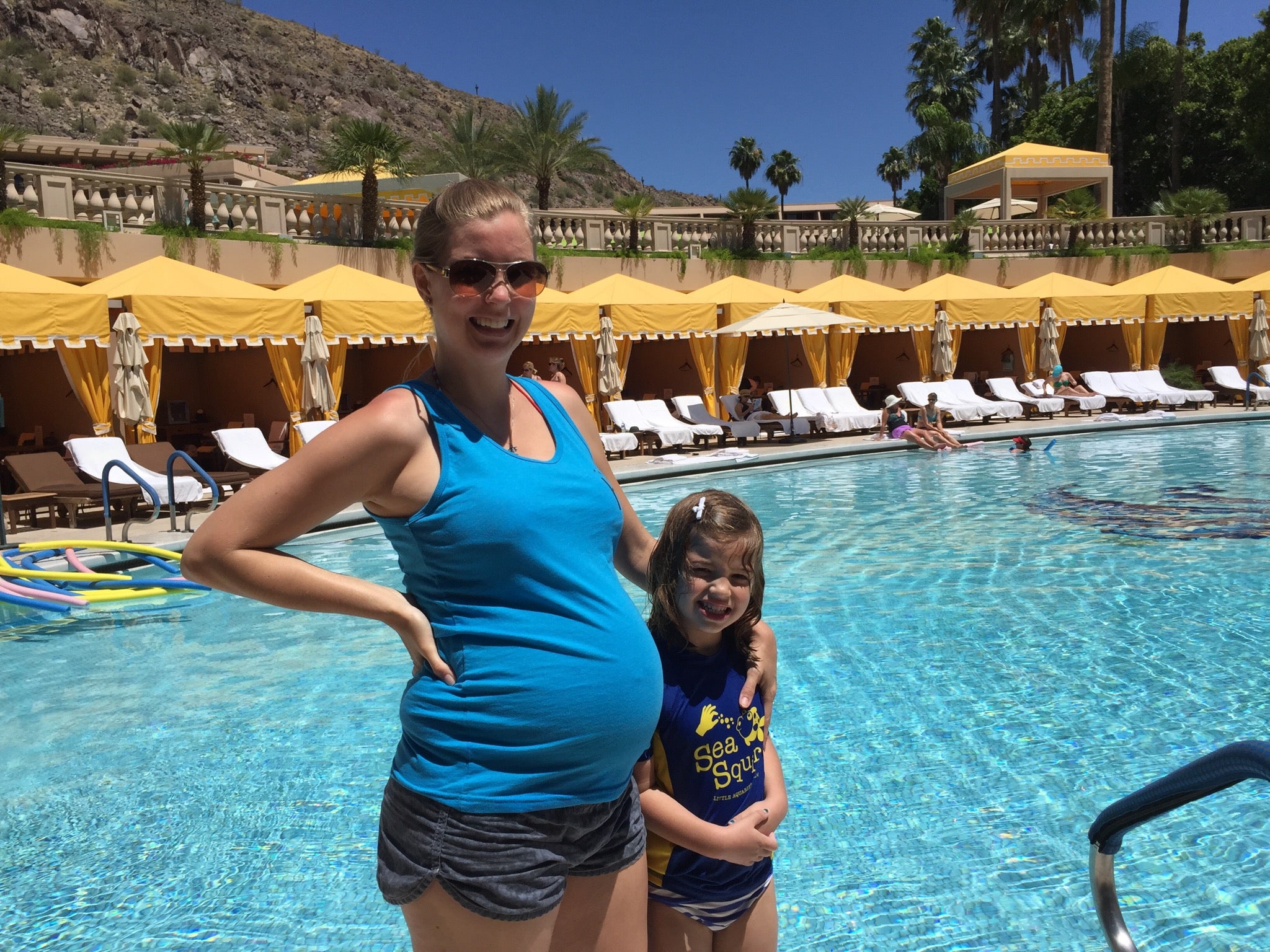
You are going to get uncomfortable
Maybe this isn't universal and there are some magical creatures out there who never feel uncomfortable during pregnancy, but every mom I know eventually hit a point in her pregnancy when she wasn't comfortable. For many, this means that sitting for an extended time in a small airline seat, standing in long lines or trekking around in the heat to explore a city all day eventually become pretty miserable activities.
No one can tell you when you will hit that point, but it will likely happen in the third trimester. For me, my back started giving me a bunch of trouble at around week 30 or 31. I was incredibly grateful there were no more flights scheduled during that pregnancy beyond that point.
If you are going to fly during the later weeks of your third trimester and have the ability to secure a more comfortable seat up front, or at least one with extra legroom so you can stretch out, it may well be a good investment in your comfort. I brought a tennis ball with me when I flew so I could give myself a bit of a "back massage" against the airplane seat.

Bring your own pillows
Sleep becomes a challenge in the third trimester for many women and a pillow fort of sorts becomes a necessity to get some good shut-eye. Many pregnant moms find that using some sort of body pillow or pillow arrangement helps to keep their bellies supported and comfortable at night. You can't assume that the hotel will have similar pillows, so bring your own if they become essential to good rest in your third trimester. I had no shame in hauling my pillow fort with me on our last road trip at eight months pregnant.
See if you are allowed to fly
Even if your doctor OKs it, many airlines have rules about women flying in the third trimester. Check out airline rules for traveling while pregnant for complete details, but generally speaking, most U.S. airlines don't have many flight restrictions until the last month of pregnancy. However, many international airlines do have restrictions and documentation requirements beginning at 28 weeks. If you are pregnant with more than one baby, the restrictions kick in even earlier.
Decide when to stop traveling
I'm all for traveling while pregnant but, realistically, most women will want to stop traveling at some point in the third trimester. I would imagine by about 36 or 37 weeks, most women will probably decide to stay closer to home. I went on a road trip about three hours from home at 35 weeks and then called it quits for the rest of the pregnancy. There's still a whole new world of travel waiting once a new baby joins the family .

Bottom line
There is usually no reason to stop traveling when you're expecting. During my last pregnancy, I went on 12 trips, 28 flights, visited four countries and I'm very glad I had the opportunity to stay that active. I'm also glad that I grounded myself from flight after 31 weeks and from road trips at 35 weeks because those were the right decisions for my comfort level.
Your cart is empty
Have an account?
Log in to check out faster.
Estimated total
Free shipping on all orders
Country/region
- USD $ | Afghanistan
- USD $ | Åland Islands
- USD $ | Albania
- USD $ | Algeria
- USD $ | Andorra
- USD $ | Angola
- USD $ | Anguilla
- USD $ | Antigua & Barbuda
- USD $ | Argentina
- USD $ | Armenia
- USD $ | Aruba
- USD $ | Ascension Island
- USD $ | Australia
- USD $ | Austria
- USD $ | Azerbaijan
- USD $ | Bahamas
- USD $ | Bahrain
- USD $ | Bangladesh
- USD $ | Barbados
- USD $ | Belarus
- USD $ | Belgium
- USD $ | Belize
- USD $ | Benin
- USD $ | Bermuda
- USD $ | Bhutan
- USD $ | Bolivia
- USD $ | Bosnia & Herzegovina
- USD $ | Botswana
- USD $ | Brazil
- USD $ | British Indian Ocean Territory
- USD $ | British Virgin Islands
- USD $ | Brunei
- USD $ | Bulgaria
- USD $ | Burkina Faso
- USD $ | Burundi
- USD $ | Cambodia
- USD $ | Cameroon
- USD $ | Canada
- USD $ | Cape Verde
- USD $ | Caribbean Netherlands
- USD $ | Cayman Islands
- USD $ | Central African Republic
- USD $ | Chad
- USD $ | Chile
- USD $ | China
- USD $ | Christmas Island
- USD $ | Cocos (Keeling) Islands
- USD $ | Colombia
- USD $ | Comoros
- USD $ | Congo - Brazzaville
- USD $ | Congo - Kinshasa
- USD $ | Cook Islands
- USD $ | Costa Rica
- USD $ | Côte d’Ivoire
- USD $ | Croatia
- USD $ | Curaçao
- USD $ | Cyprus
- USD $ | Czechia
- USD $ | Denmark
- USD $ | Djibouti
- USD $ | Dominica
- USD $ | Dominican Republic
- USD $ | Ecuador
- USD $ | Egypt
- USD $ | El Salvador
- USD $ | Equatorial Guinea
- USD $ | Eritrea
- USD $ | Estonia
- USD $ | Eswatini
- USD $ | Ethiopia
- USD $ | Falkland Islands
- USD $ | Faroe Islands
- USD $ | Fiji
- USD $ | Finland
- USD $ | France
- USD $ | French Guiana
- USD $ | French Polynesia
- USD $ | French Southern Territories
- USD $ | Gabon
- USD $ | Gambia
- USD $ | Georgia
- USD $ | Germany
- USD $ | Ghana
- USD $ | Gibraltar
- USD $ | Greece
- USD $ | Greenland
- USD $ | Grenada
- USD $ | Guadeloupe
- USD $ | Guatemala
- USD $ | Guernsey
- USD $ | Guinea
- USD $ | Guinea-Bissau
- USD $ | Guyana
- USD $ | Haiti
- USD $ | Honduras
- USD $ | Hong Kong SAR
- USD $ | Hungary
- USD $ | Iceland
- USD $ | India
- USD $ | Indonesia
- USD $ | Iraq
- USD $ | Ireland
- USD $ | Isle of Man
- USD $ | Israel
- USD $ | Italy
- USD $ | Jamaica
- USD $ | Japan
- USD $ | Jersey
- USD $ | Jordan
- USD $ | Kazakhstan
- USD $ | Kenya
- USD $ | Kiribati
- USD $ | Kosovo
- USD $ | Kuwait
- USD $ | Kyrgyzstan
- USD $ | Laos
- USD $ | Latvia
- USD $ | Lebanon
- USD $ | Lesotho
- USD $ | Liberia
- USD $ | Libya
- USD $ | Liechtenstein
- USD $ | Lithuania
- USD $ | Luxembourg
- USD $ | Macao SAR
- USD $ | Madagascar
- USD $ | Malawi
- USD $ | Malaysia
- USD $ | Maldives
- USD $ | Mali
- USD $ | Malta
- USD $ | Martinique
- USD $ | Mauritania
- USD $ | Mauritius
- USD $ | Mayotte
- USD $ | Mexico
- USD $ | Moldova
- USD $ | Monaco
- USD $ | Mongolia
- USD $ | Montenegro
- USD $ | Montserrat
- USD $ | Morocco
- USD $ | Mozambique
- USD $ | Myanmar (Burma)
- USD $ | Namibia
- USD $ | Nauru
- USD $ | Nepal
- USD $ | Netherlands
- USD $ | New Caledonia
- USD $ | New Zealand
- USD $ | Nicaragua
- USD $ | Niger
- USD $ | Nigeria
- USD $ | Niue
- USD $ | Norfolk Island
- USD $ | North Macedonia
- USD $ | Norway
- USD $ | Oman
- USD $ | Pakistan
- USD $ | Palestinian Territories
- USD $ | Panama
- USD $ | Papua New Guinea
- USD $ | Paraguay
- USD $ | Peru
- USD $ | Philippines
- USD $ | Pitcairn Islands
- USD $ | Poland
- USD $ | Portugal
- USD $ | Qatar
- USD $ | Réunion
- USD $ | Romania
- USD $ | Russia
- USD $ | Rwanda
- USD $ | Samoa
- USD $ | San Marino
- USD $ | São Tomé & Príncipe
- USD $ | Saudi Arabia
- USD $ | Senegal
- USD $ | Serbia
- USD $ | Seychelles
- USD $ | Sierra Leone
- USD $ | Singapore
- USD $ | Sint Maarten
- USD $ | Slovakia
- USD $ | Slovenia
- USD $ | Solomon Islands
- USD $ | Somalia
- USD $ | South Africa
- USD $ | South Georgia & South Sandwich Islands
- USD $ | South Korea
- USD $ | South Sudan
- USD $ | Spain
- USD $ | Sri Lanka
- USD $ | St. Barthélemy
- USD $ | St. Helena
- USD $ | St. Kitts & Nevis
- USD $ | St. Lucia
- USD $ | St. Martin
- USD $ | St. Pierre & Miquelon
- USD $ | St. Vincent & Grenadines
- USD $ | Sudan
- USD $ | Suriname
- USD $ | Svalbard & Jan Mayen
- USD $ | Sweden
- USD $ | Switzerland
- USD $ | Taiwan
- USD $ | Tajikistan
- USD $ | Tanzania
- USD $ | Thailand
- USD $ | Timor-Leste
- USD $ | Togo
- USD $ | Tokelau
- USD $ | Tonga
- USD $ | Trinidad & Tobago
- USD $ | Tristan da Cunha
- USD $ | Tunisia
- USD $ | Türkiye
- USD $ | Turkmenistan
- USD $ | Turks & Caicos Islands
- USD $ | Tuvalu
- USD $ | U.S. Outlying Islands
- USD $ | Uganda
- USD $ | Ukraine
- USD $ | United Arab Emirates
- USD $ | United Kingdom
- USD $ | United States
- USD $ | Uruguay
- USD $ | Uzbekistan
- USD $ | Vanuatu
- USD $ | Vatican City
- USD $ | Venezuela
- USD $ | Vietnam
- USD $ | Wallis & Futuna
- USD $ | Western Sahara
- USD $ | Yemen
- USD $ | Zambia
- USD $ | Zimbabwe

Bike Riding in Early Pregnancy: Things You Need to Know
Expecting mothers face a lot of questions regarding what to do and what not to do during pregnancy.
While some say bike riding is good for the mood and overall general well being of the child, a different school of opinion says that bike riding should totally be avoided during pregnancy as it causes too much exertion for the baby.
Source: She Knows
CAN CYCLING BE DONE DURING PREGNANCY?
Yes, the American Congress of Obstetricians and Gynecologists declared light bike riding with proper precautionary measures absolutely safe during the first trimester .
The expecting mother needs to avoid overexertion and stick to slow and steady riding without causing any jolts to the belly .
WHAT ARE THE BENEFITS OF CYCLING DURING PREGNANCY?
One of the major advantages of cyling riding during early pregnancy is the prevention of problems such as gestational diabetes . It avoids excessive weight gain and if your body is used to exercise, during pregnancy it will adapt more easily. Cycling, bike riding, or in fact any form of cardiovascular activity keeps your heart ( and your baby's heart! ) healthy and fit.
Commonly reported problems among pregnant women like fatigue, insomnia, stress, and anxiety are reduced by light cardio as it lifts the mood and enhances the metabolism of the body entirely.
The increased body activity can increase the blood flow and help you sleep better at night. It also helps reduce muscle pain and if biking has always been one of your favorite outdoor activities, then there is absolutely no harm in nurturing your passion for the same, during the first trimester at least.
Cycling can also help beat the monotony of daily life since many of us have been forced to spend more time indoors due to COVID.
BIKING IN THE FIRST TRIMESTER

If you have been an active rider and have been undertaking a lot of cycling activity, you need to slow down a bit during pregnancy. The Royal College of Obstetricians and Gynecologists advise pregnant women to undertake it with ‘particular care’. The fetus develops rapidly in the first trimester. This is generally considered a tough time for both the mother and the child. Developmental delays and birth defects typically occur during the first trimester.
BIKING IN THE SECOND AND THIRD TRIMESTER
The mother needs to be extra cautious while bike riding as any major jolts or falls can be life-threatening for the child. Moreover, bike riding is easy in the first trimester as compared to the later ones as the body has still not expanded much and balancing the bike is not much of an issue. It nearly becomes impossible during the later stages due to the baby bump and the added body fat.
TIPS FOR SAFE CYCLING FOR EXPECTING MOTHERS

Bike riding is not at all harmful to expecting mothers if undertaken with proper care. The two major risks involved are falling off the bike thus ultimately injuring the fetus, or overexerting oneself thus causing problems for the baby. The baby can be oxygen deprived if you exert yourself too much and do not take proper breaks for resting.
Avoid biking alone
Biking alone can should be avoided as you progress through pregnancy. Take your partner or anyone else along. This will make help easily accessible in case of an emergency. Do not ride out of your comfort zone. Take your cell phone along if you do not have anyone to accompany you and always make sure to keep your partner or a friend updated about your location and status.
In Closing Bike riding is fun and healthy but only if you undertake it with proper precaution and care!
Most importantly, consult your doctor before setting out on the ride. If you have any kind of medical complications like cardiovascular disease, dizziness, restrictive lung disease, vaginal bleeding, or even excessive weakness then you should avoid bike riding. Getting a clearance certificate from your doctor is necessary before exploring the roads on a bike. Any kind of carelessness can have long-term effects on the baby and the mother too.
What to Read Next:
Top 5 Moves to Make Labor Easier
5 Ways To Cope With Back Pain During Pregnancy
Pregnancy Exercises to Prepare for a VBAC
About the Author:
Jessica is a traveler by heart. She loves to pen down her thoughts related to her travel experiences and her knowledge about motorcycle adventure products to keep one’s safe and enjoy the ride. She loves to meet new people during her trips.
Subscribe to our emails
Be the first to know about new collections and exclusive offers.
- Choosing a selection results in a full page refresh.
- Opens in a new window.
Travelling in pregnancy
With the proper precautions such as travel insurance, most women can travel safely well into their pregnancy.
Wherever you go, find out what healthcare facilities are at your destination in case you need urgent medical attention. It's a good idea to take your maternity medical records (sometimes called handheld notes) with you so you can give doctors the relevant information if necessary.
Find out more about getting healthcare abroad .
Make sure your travel insurance covers you for any eventuality, such as pregnancy-related medical care during labour, premature birth and the cost of changing the date of your return trip if you go into labour .
When to travel in pregnancy
Some women prefer not to travel in the first 12 weeks of pregnancy because of nausea and vomiting and feeling very tired during these early stages. The risk of miscarriage is also higher in the first 3 months, whether you're travelling or not.
Travelling in the final months of pregnancy can be tiring and uncomfortable. So, many women find the best time to travel or take a holiday is in mid-pregnancy, between 4 and 6 months.
Flying in pregnancy
Flying isn't harmful to you or your baby, but discuss any health issues or pregnancy complications with your midwife or doctor before you fly.
The chance of going into labour is naturally higher after 37 weeks (around 32 weeks if you're carrying twins), and some airlines won't let you fly towards the end of your pregnancy. Check with the airline for their policy on this.
After week 28 of pregnancy, the airline may ask for a letter from your doctor or midwife confirming your due date, and that you are not at risk of complications. You may have to pay for the letter and wait several weeks before you get it.
Long-distance travel (longer than 4 hours) carries a small risk of blood clots (deep vein thrombosis (DVT)) . If you fly, drink plenty of water and move about regularly – every 30 minutes or so. You can buy a pair of graduated compression or support stockings from the pharmacy, which will help reduce leg swelling.
Travel vaccinations when you're pregnant
Most vaccines that use live bacteria or viruses aren't recommended during pregnancy because of concerns that they could harm the baby in the womb.
However, some live travel vaccines may be considered during pregnancy if the risk of infection outweighs the risk of live vaccination. Ask your GP or midwife for advice about specific travel vaccinations. Non-live (inactivated) vaccines are safe to use in pregnancy.
Malaria tablets
Some anti-malaria tablets aren't safe to take in pregnancy so ask your GP for advice.
Zika virus is mainly spread by mosquitoes found in some parts of the world. For most people it's mild and not harmful, but can cause problems if you're pregnant.
If you are pregnant, it is not recommended to travel to parts of the world where the Zika virus is present, such as parts of:
- South and Central America
- the Caribbean
- the Pacific islands
Check before you travel
It's important to check the risk for the country you're going to before you travel.
Find out more about the Zika virus risk in specific countries on the Travel Health Pro website
Car travel in pregnancy
It's best to avoid long car journeys if you're pregnant. However, if it can't be avoided, make sure you stop regularly and get out of the car to stretch and move around.
You can also do some exercises in the car (when you're not driving), such as flexing and rotating your feet and wiggling your toes. This will keep the blood flowing through your legs and reduce any stiffness and discomfort. Wearing compression stockings while on long car journeys (more than 4 hours) can also increase the blood flow in your legs and help prevent blood clots.
Tiredness and dizziness are common during pregnancy so it's important on car journeys to drink regularly and eat natural, energy-giving foods, such as fruit and nuts.
Keep the air circulating in the car and wear your seatbelt with the cross strap between your breasts and the lap strap across your pelvis under your bump, not across your bump.
Road accidents are among the most common causes of injury in pregnant women. If you have to make a long trip, don't travel on your own. You could also share the driving with your companion.
Sailing in pregnancy
Ferry companies have their own restrictions and may refuse to carry heavily pregnant women (often beyond 32 weeks on standard crossings and 28 weeks on high-speed crossings ). Check the ferry company's policy before you book.
For longer boat trips, such as cruises, find out if there are onboard facilities to deal with pregnancy and medical services at the docking ports.
Food and drink abroad in pregnancy
Take care to avoid food- and water-borne conditions, such as stomach upsets and travellers' diarrhoea . Some medicines for treating stomach upsets and travellers' diarrhoea aren't suitable during pregnancy.
Always check if tap water is safe to drink. If in doubt, drink bottled water. If you get ill, keep hydrated and continue eating for the health of your baby, even if you're not hungry.
Find out about a healthy diet in pregnancy , and foods to avoid in pregnancy .
Page last reviewed: 17 August 2022 Next review due: 17 August 2025
Appointments at Mayo Clinic
- Pregnancy week by week
Is it safe to fly during pregnancy?
Generally, air travel before 36 weeks of pregnancy is considered safe for people who aren't dealing with any pregnancy problems. Still, if you're pregnant, it's a good idea to talk with your health care provider before you fly.
Your provider might suggest that you not fly if you have certain pregnancy complications that could get worse because of air travel or that could require emergency care. Examples include a history of miscarriage or vaginal bleeding, severe anemia, and high blood pressure or diabetes that's not well controlled. If you had preeclampsia during a previous pregnancy — a condition that causes high blood pressure and extra protein in urine — flying may not be advised. The same is true if you're pregnant with twins or other multiples.
Tell your provider how far you are flying, as the length of the flight might make a difference. Also, be aware that some airlines may not allow pregnant people on international flights. Check with your airline before you make travel arrangements.
After 36 weeks of pregnancy, your health care provider may advise against flying. And some airlines don't allow pregnant people to fly after 36 weeks. The airline also may require a letter from your health care provider that states how far along in your pregnancy you are and whether flying is advised.
If your health care provider says it's okay for you to fly, and your plans are flexible, the best time to travel by air might be during the second trimester. The risks of common pregnancy emergencies are lowest during that time.
When you fly:
- Buckle up. During the trip, keep your seatbelt fastened when you are seated, and secure it under your belly.
- Drink plenty of fluids. Low humidity in the airplane could cause you to become dehydrated.
- Avoid gassy foods and drinks before you fly. Gases expand during flight, and that could make you uncomfortable. Examples of foods and drinks to avoid include broccoli and carbonated soda.
- Think about medical care. Plan for how you'll get obstetric care during your trip if you need it. Bring copies of your medical information in case you need care while you're away.
Blood clots
Air travel can raise the risk for blood clots in the legs, a condition called venous thrombosis. The risk is higher for pregnant people. Moving your legs may help prevent this problem. Take a walk up and down the aisle every hour during the flight. If you must remain seated, flex and extend your ankles from time to time. In general, it's best to avoid tightfitting clothing, as that can hinder blood flow. Wearing compression stockings can help with blood circulation during a long flight.
Radiation exposure linked to air travel at high altitudes isn't thought to be a problem for most people who fly during pregnancy. But pilots, flight attendants and others who fly often might be exposed to a level of radiation that raises concerns during pregnancy. If you must fly frequently during your pregnancy, talk about it with your health care provider.
Mary Marnach, M.D.
There is a problem with information submitted for this request. Review/update the information highlighted below and resubmit the form.
From Mayo Clinic to your inbox
Sign up for free and stay up to date on research advancements, health tips, current health topics, and expertise on managing health. Click here for an email preview.
Error Email field is required
Error Include a valid email address
To provide you with the most relevant and helpful information, and understand which information is beneficial, we may combine your email and website usage information with other information we have about you. If you are a Mayo Clinic patient, this could include protected health information. If we combine this information with your protected health information, we will treat all of that information as protected health information and will only use or disclose that information as set forth in our notice of privacy practices. You may opt-out of email communications at any time by clicking on the unsubscribe link in the e-mail.
Thank you for subscribing!
You'll soon start receiving the latest Mayo Clinic health information you requested in your inbox.
Sorry something went wrong with your subscription
Please, try again in a couple of minutes
- Allergy medications during pregnancy
- AskMayoExpert. Health considerations for air travelers: Pregnancy considerations. Mayo Clinic; 2022.
- Air Travel During Pregnancy: ACOG Practice Bulletin No. 746. American College of Obstetricians and Gynecologists. https://www.acog.org/clinical/clinical-guidance/committee-opinion/articles/2018/08/air-travel-during-pregnancy. Accessed Dec. 1, 2022.
- Ram S, et al. Air travel during pregnancy and the risk of venous thrombosis. American Journal of Obstetrics and Gynecology. 2022; doi:10.1016/j.ajogmf.2022.100751.
Products and Services
- A Book: Taking Care of You
- Available Solutions for Prenatal Nutrition from Mayo Clinic Store
- A Book: Obstetricks
- A Book: Mayo Clinic Guide to a Healthy Pregnancy
- Ankle swelling during pregnancy
- Antibiotics and pregnancy
- Aspirin during pregnancy
- Pregnancy back pain
- Falling during pregnancy: Reason to worry?
- Fetal ultrasound
- Flu shot in pregnancy
- Headaches during pregnancy: What's the best treatment?
- Iron deficiency anemia during pregnancy: Prevention tips
- Leg cramps during pregnancy
- Pregnancy acne
- Pregnancy and fish
- Pregnancy constipation
- Pregnancy diet: Essential nutrients
- Pregnancy due date calculator
- Pregnancy exercises
- Pregnancy nutrition don'ts
- Pregnancy stretches
- Pregnancy weight gain
- Pregnant. Now What Happens?
- Prenatal testing
- Prenatal vitamins and pregnancy
- Sex during pregnancy
- Twin pregnancy
- Vaccines during pregnancy
- Vaping during pregnancy
- Working during pregnancy
- X-ray during pregnancy
Mayo Clinic does not endorse companies or products. Advertising revenue supports our not-for-profit mission.
- Opportunities
Mayo Clinic Press
Check out these best-sellers and special offers on books and newsletters from Mayo Clinic Press .
- Mayo Clinic on Incontinence - Mayo Clinic Press Mayo Clinic on Incontinence
- The Essential Diabetes Book - Mayo Clinic Press The Essential Diabetes Book
- Mayo Clinic on Hearing and Balance - Mayo Clinic Press Mayo Clinic on Hearing and Balance
- FREE Mayo Clinic Diet Assessment - Mayo Clinic Press FREE Mayo Clinic Diet Assessment
- Mayo Clinic Health Letter - FREE book - Mayo Clinic Press Mayo Clinic Health Letter - FREE book
- Healthy Lifestyle
- Expert Answers
- Air travel during pregnancy Is it safe
Your gift holds great power – donate today!
Make your tax-deductible gift and be a part of the cutting-edge research and care that's changing medicine.
- Infertility
- Miscarriage & Loss
- Pre-Pregnancy Shopping Guides
- Diapering Essentials
- Bedtime & Bathtime
- Baby Clothing
- Health & Safety
- First Trimester
- Second Trimester
- Third Trimester
- Pregnancy Products
- Baby Names By Month
- Popular Baby Names
- Unique Baby Names
- Labor & Delivery
- Birth Stories
- Fourth Trimester
- Parental Leave
- Postpartum Products
- Sleep Guides & Schedules
- Feeding Guides & Schedules
- Milestone Guides
- Learn & Play
- Beauty & Style Shopping Guides
- Meal Planning & Shopping
- Entertaining
- Personal Essays
- Home Shopping Guides
- Work & Motherhood
- Family Finances & Budgeting
- State of Motherhood
Viral & Trending
- Celebrity News
- Women’s Health
- Children’s Health
- It’s Science
- Mental Health
- Health & Wellness Shopping Guide
- What To Read
- What To Watch
- Mother’s Day
- Memorial Day
- Summer prep
- Single Parenting
- Blended Families
- Community & Friendship
- Marriage & Partnerships
- Grandparents & Extended Families
- Stretch Mark Cream
- Pregnancy Pillows
- Maternity Pajamas
- Maternity Workout Clothes
- Compression Socks
- All Pregnancy Products
- Pikler Triangles
- Toddler Sleep Sacks
- Toddler Scooters
- Water Tables
- All Toddler Products
- Breastmilk Coolers
- Postpartum Pajamas
- Postpartum Underwear
- Postpartum Shapewear
- All Postpartum Products
- Kid Pajamas
- Play Couches
- Kids’ Backpacks
- Kids’ Bikes
- Kids’ Travel Gear
- All Child Products
- Baby Swaddles
- Eco-Friendly Diapers
- Baby Bathtubs
- All Baby Products
- Pregnancy-safe Skincare
- Diaper Bags
- Maternity Jeans
- Matching Family Swimwear
- Mama Necklaces
- All Beauty and Style Products
- All Classes
- Free Classes By Motherly
- Parenting & Family Topics
- Toddler Topics
- TTC & Pregnancy
- Wellness & Fitness

- Please wait..
Hilarious video of husband secretly enjoying his wife’s TV shows goes viral

@twicietannies/X/@hayleypearll/TikTok
"Stealth mode" is sending us.
By Christina Marfice May 28, 2024
This one is for all the girlies who have been binge-watching the new season of Bridgerton lately. Or any other TV show that your husband pretends is “bad taste.”
We all know we have superior taste in TV, even when our husbands, boyfriends, and male partners try to deny it. And while they may scoff at shows like Bridgerton, Love is Blind, 90 Day Fiancé, and Vanderpump Rules , can they actually resist the allure of such high-quality content? Certain viral videos would say no. Like this one, which shows the different “stages” of a husband claiming he doesn’t like Bridgerton as he actually gets more and more into it.
HELPSJFDJD pic.twitter.com/hrDM9BGNRo — 산 San POLIN TIME 🇨🇮🪞🩵+💛 (@twicietannies) May 23, 2024
The video, originally posted to TikTok and then cross-posted on Twitter, shows glimpses of Penelope and Colin’s love story playing out on the TV as the husband in question goes through four stages. The first is “Reluctant retreat,” where he pretends he doesn’t care about the show, but actually lingers way too long at the bottom of the stairs because, um, he actually clearly wants to watch.
Related: ‘Bridgerton’ season 3 has everyone crying, screaming, throwing up—because it’s SO GOOD
Stage 2 is “Finding excuses to come back and watch,” where he’s in the kitchen “just to get a drink.” Uh huh. Sure he is. He’s thirsty for more Polin makeouts, just like we all are.
Stage 3, which is absolutely sending us, is “Stealth mode,” in which he tries to sneakily watch the show from the loft above the living room, fooling absolutely no one.
And finally, Stage 4 is “Acceptance,” when he just sits down on the couch and watches a good show because life is too short to go through all of this.
TikTok is absolutely full of videos like this, because apparently it’s a real thing for male partners to refuse to admit they’re into reality TV, romance shows, soap operas, etc.
@alexandramadison_ He’s been a fan the entire time ♬ original sound – Alex and Jon
@kevincooneyy How blind is the love tho? ♬ original sound – Kevin Cooney
Related: Husband hilariously parodies how his wife thinks guests react in viral TikTok
Except they are. Because these shows are great and no human can resist the drama.
@erin.dayhaw Recorded my husband’s commentary to the carriage scene 😂 the cat is a paid actor Bridgerton Season 3 Part 1 #bridgerton #bridgertonseason3 #carriagescene #husbandsoftiktok ♬ original sound – Erin Dayhaw
Boys, it’s OK. This is a safe space and you can just cuddle up with a blanket and watch Bridgerton . No one will judge you for loving an objectively fantastic show.

The review and comments about this viral ‘hospital gown dress’ will make you LOL
Nanny shares examples of text messages from parents over pay: ‘my jaw dropped’, health & wellness, new study shows adhd cases are on the rise—and now affect 1 in 9 kids, cemetery baby name inspo may be a new trend, based on this mom’s viral video, our editors also recommend....

- Vishal's account
- Prenatal Care
Riding a Two Wheeler During Pregnancy – Precautions & Safety Tips

Is It Safe to Ride a Two-Wheeler During Pregnancy?
Risks while riding a 2 wheeler in pregnancy, precautions to take when you ride on a two-wheeler during pregnancy, ways to avoid a two-wheeler ride when pregnant.
A lot of women prefer using a two-wheeler to run errands or to travel to work as it saves time and the hassle of parking. However, during pregnancy, women may have to make certain changes in their usual lifestyle. A pregnant woman needs to take extra care of her safety and health, so the question of using a two-wheeler during pregnancy will naturally arise.
The fluctuating hormones and the resulting sickness, fatigue , nausea and pain , along with a growing belly can render riding a two-wheeler during pregnancy uncomfortable and risky. It may lead to erroneous driving, thereby increasing the risk of a likely road accident. In fact, some women may even have to avoid all forms of travelling during the second or third trimesters of pregnancy . So, the question of riding a two-wheeler or not naturally arises during this time. To help you with this, we have covered some precautions that you must take while driving. Let’s read!
Many pregnant women may question if it is safe to ride a two-wheeler while pregnant. Well, riding a two-wheeler during pregnancy is safe, provided you take extra care. A pregnant woman while riding a two-wheeler may be more susceptible to losing her balance and falling. Unlike in a car , two-wheelers don’t have airbags to protect in case of a crash. Moreover, on a two-wheeler, one is more exposed to rough roads.
Some people think the risk of riding a two-wheeler during the first trimester is slightly lesser when compared to the risks involved in riding a two-wheeler during the later stages of pregnancy. However, riding a two-wheeler is not allowed in any trimester . In case you are still doubtful of whether you should be riding a bike during pregnancy in the first trimester , it is always sensible to consult your doctor for guidance.
Having said that, if you do have to ride a two-wheeler during pregnancy, you must take certain precautions and ensure it is a one-off case. It’s better that your body and the foetus growing inside your womb doesn’t go through any physical trauma while riding a two-wheeler.
While it is safe to ride a two-wheeler during pregnancy, there are still some risks associated with it. Let’s take a look at them:
- A pregnant woman may have hypertension/giddiness & difficulty in balancing, therefore, may fall.
- Falls from two-wheeler riding can leave you with some nasty cuts and bruises as well as a head injury.
- Falling from two-wheeler may hurt your baby and can even cause miscarriage .
- Many small, convex and concave roads make pregnant women riding two-wheeler shock and adversely affect the foetus.
It may not be entirely possible to avoid riding a two-wheeler during pregnancy, but you can always keep the following precautions in mind when you do:
- Always wear a helmet while driving a two-wheeler, even while riding pillion.
- Wear comfortable flat shoes instead of heels or strappy sandals.
- Avoid driving during rush hours.
- Exploring new or longer routes may not be such a good idea. Stick to familiar, short routes.
- In case you are riding on a two-wheeler at nighttime, put on a neon or bright coloured jacket that is easily visible from distance.
- During the rainy season, roads can be slippery. Avoid riding your two-wheeler on wet roads or immediately after it has rained. Water can cover the potholes, making it difficult for you to identify them.
- If your scooter does not have a self-start, it is best to take someone’s help as you may accidentally jerk too hard while kickstarting the scooter yourself.
- Familiarise yourself with healthcare centres along the route on which you are travelling in case of an emergency.
- Take special care on turns and speed breakers. Avoid speeding and overtaking other vehicles to prevent any accidents.
- Always carry along a bottle of water, your phone fully charged, and a healthy snack.
- Choose comfortable and suitable clothing according to the weather.
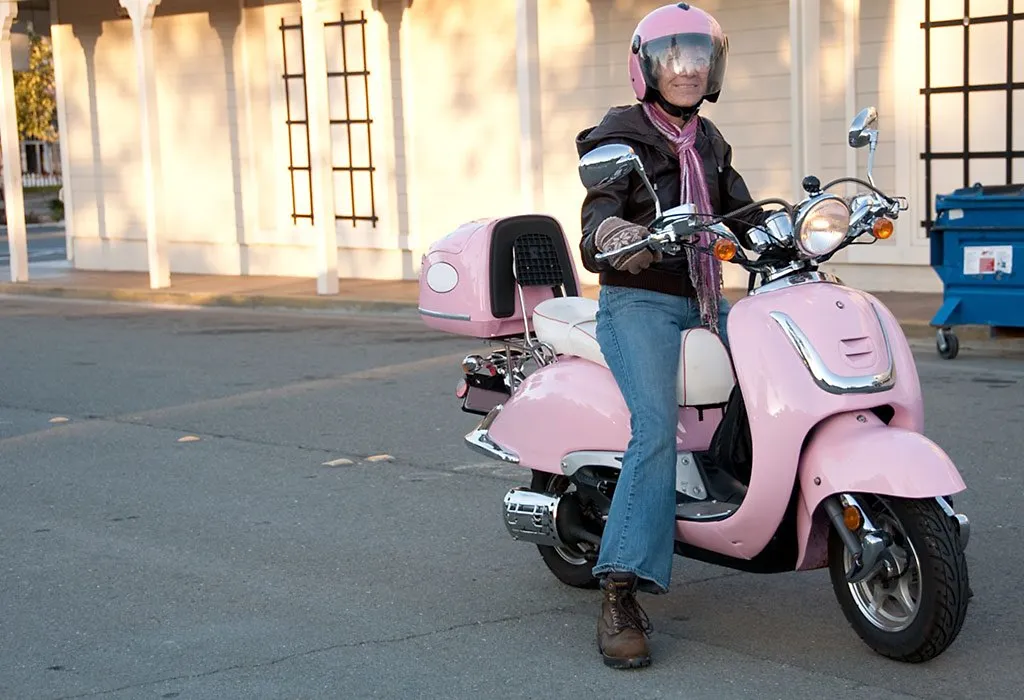
You may want to avoid a two-wheeler ride as soon as your pregnancy is confirmed. Sudden jerks or a bumpy ride or a bad fall may result in premature delivery and other pregnancy complications . Here’s how you can safely travel without the help of a two-wheeler:
- In case you are a working woman, you can seek your colleagues’ help and arrange a carpool with them to travel to work. You can also inquire from neighbours or friends and make a similar arrangement.
- You can avail cab services that offer cabs at economical rates. These cab services also have the option of sharing a ride, which can further reduce the cost of travel.
- You can also consider public transport like trains , particularly metros and buses . When taking a bus, ensure you request the conductor and the driver to drive carefully.
- You can always talk to your boss and organise flexible work hours that are better suited to your carpooling arrangement, so you get to avoid peak traffic hours.
- You can also work from home in case your company allows it.
- You can download various apps on your phone that offer home deliveries and services at your doorstep.
- Don’t shy away from asking the help of your family members or friends to drive you to the market or anywhere else you need to be. People usually are more than ready to help a pregnant lady!
1. Can Speed Bumps Affect My Pregnancy?
While driving 2 wheeler in pregnancy, it is common to come across speed bumps. Studies shows that speed bumps, if driven over quickly, can lead to minor injuries to the foetal brain, cause an abnormal foetal heart rate, abdominal pain, uterine contraction, increasing uterine activity, and other complications.
2. When Should I Stop Riding or Driving While Pregnant?
Driving while pregnant is totally fine, if you are following all safety precautions. But as your pregnancy progresses, the risk increases. So, if you feel even a little bit uncomfortable while driving, you must immediately stop.
3. Can Sudden Break Harm My Baby or Cause Miscarriage?
While driving, sudden brakes can still potentially separate the placenta from the uterus . Sometimes, even applying minor brakes is enough to potentially cause injuries like placental abruption . Therefore, be careful while driving during pregnancy.
Riding a two-wheeler during pregnancy is not a big problem. The main hurdle lies in the condition of the roads, which are usually full of potholes and other things that can cause a bumpy, uncomfortable ride. Maddening traffic, people’s tendency to disregard basic traffic rules and to create dangerous situations can result in an accident. Therefore, it makes sense to avoid exposing yourself to such potentially hazardous situations during pregnancy.
References/Resources:
1. Baby on Board: 10 Tips for Riding While Pregnant; peopleforbikes.org; https://www.peopleforbikes.org/news/baby-on-board-10-tips-for-riding-while-pregnant
2. Biking with a bump: Should you ride while pregnant?; bikeportland.org; https://bikeportland.org/2009/02/03/biking-with-a-bump-should-you-ride-while-pregnant-14100
3. Catherine J. Vladutiu, Harold B. Weiss; Motor vehicle safety during pregnancy; National Library of Medicine; https://www.ncbi.nlm.nih.gov/pmc/articles/PMC3662299/ ; October 2011
4. TRAVELLING IN PREGNANCY – DO’S AND DON’T; narayanahealth.org; https://www.narayanahealth.org/blog/travelling-in-pregnancy-dos-and-dont/
5. Cycling with a bump – is it safe to ride while pregnant?; cyclinguk.org; https://www.cyclinguk.org/blog/victoria-hazael/cycling-bump-it-safe-to-ride-whilst-pregnant
Also Read:
Air Travel in Pregnancy Travelling during Pregnancy Is It Safe to Go Boating while Pregnant?
- RELATED ARTICLES
- MORE FROM AUTHOR

Can Cats Sense Pregnancy?

Pelvic Rest during Pregnancy: Reasons & Benefits

Social Distancing Baby Shower Ideas & Tips

List of 15 Pregnancy Symptoms You Shouldn't Ignore

Baby Shower Trivia Questions & Answers for To-Be Parents and Guests

Oral Sex During Pregnancy - What's Ok and What's Not
Popular on parenting.

245 Rare Boy & Girl Names with Meanings

Top 22 Short Moral Stories For Kids

170 Boy & Girl Names That Mean 'Gift from God'

800+ Unique & Cute Nicknames for Boys & Girls
Latest posts.

Understanding Baby Food Labels - Easy Guide for Parents on How to Read & Use

5 Ways to Maintain Diaper Hygiene in Summer for a Happy Baby!

4 Baby Sleep-Related Questions All New Parents Have Answered by a Paediatrician!

Do Indian Babies Have Different Diaper Needs? Here's an Expert's Opinion!
- Search Please fill out this field.
- Newsletters
- Sweepstakes
11 Rules for Road Trips While Pregnant, Including When To Stop Traveling by Car
A car trip can be a memorable vacation while pregnant, especially if flying is out of the question, but there are some precautions to take before you hit the road.
Everyone loves a good road trip. And if you're pregnant, a babymoon by car may be exactly what's needed before you're elbows-deep in dirty diapers. While it's generally safe to fly while expecting , some airlines have a cutoff of 36 weeks (and many even earlier), according to the Centers for Disease Control and Prevention (CDC).
Pregnant people who do fly should check with their doctors first, but they can make travel safer with simple steps like holding onto seatbacks when walking during turbulence and wearing compression socks to prevent deep vein thrombosis.
The great news is that car travel is safe for most pregnant people. If you have complications, you may need to stick closer to home but unless you're on bedrest or have other doctor-imposed limitations, you should be able to hit the road. Ask your health care provider when you should stop long road trips, but in most cases, it's safe until close to your due date.
To ensure the only bump on the road is your belly, here are 11 tips pregnant travelers should know before setting off on a long drive.
1. Talk To Your Health Care Provider
No matter the mode of travel, pregnant people should always start by contacting their health care provider, said Kecia Gaither, MD , maternal-fetal medicine specialist affiliated with NYC Health + Hospitals/Lincoln in the Bronx, New York. "Certain medical conditions may preclude any degree of travel, be it by air or land," says Dr. Gaither. "Those conditions may include placenta previa , prior preterm labor , or clotting disorders."
Placenta previa, for example, happens when the placenta completely or partially covers the cervix. It can cause bleeding during pregnancy, as well as serious complications—like hemorrhage or preterm birth—that would be difficult to navigate in an unfamiliar location.
Additionally, traveling is a risk factor for blood clots, according to the CDC—and pregnant people already have a heightened chance of developing them. Certain conditions and disorders may increase the risk of blood clots too much for long road trips.
2. Plan for Your Second Trimester
The American College of Obstetricians and Gynecologists (ACOG) says the ideal time to travel is during the second trimester, between 14 and 28 weeks. "During these weeks, your energy has returned, morning sickness is improved or gone, and you are still able to get around easily," recommends the organization. "After 28 weeks, it may be harder to move around or sit for a long time."
Not only is the middle of the pregnancy when pregnant people will likely feel the best, but it also carries a lower risk of any complications.
3. Prepare for the Pregnancy Road Trip
Advanced planning can make any road trip easier. This includes thoughtful packing like easy-to-change clothing if you get too hot or too cold and taking healthy foods, snacks, and drinks. Also, make sure your route is accurate to avoid delays and check for safe places to stop.
4. Drink Enough Water
There's a link between dehydration and uterine contractions, so keeping on top of water intake is crucial, says Dr. Gaither. Have a sufficient supply of water readily available in the car and make sure to drink even more if you've been sweating or exercising. Pregnant people should drink eight to 12 cups (or 64 to 96 ounces) of water each day, according to ACOG. This ensures healthy digestion, amniotic fluid formation, and nutrient circulation.
5. Bring Extra Medications or Supplements
Taking the proper medications and supplements while pregnant is imperative, and it's even more important on a road trip. Dr. Gaither says pregnant travelers will want to double-check that they've packed any medications and vitamins they need.
It's also important to bring extra, in case they're on the road longer than originally anticipated. Include over-the-counter medicines approved by your health care provider, so you'll have them if you need them. And, don't forget to pack your prenatal vitamin !
6. Always Wear a Seat Belt
Wearing a seat belt in a car is one of the most important car safety tips, especially when you're pregnant. The myth that a seat belt could harm the fetus is pure fiction, but there's a proper way to wear one if you're pregnant, according to the National Highway Traffic Safety Administration (NHTSA).
Pregnant people should wear the shoulder belt away from their neck and across their chest. The lap belt should be secured below the belly so it fits snugly. Pregnant people should also keep as much distance as possible between their belly and the steering wheel, while still ensuring they can reach the wheel and pedals. Additionally, the NHTSA recommends pregnant people don't disable the airbags.
7. Get Out and Stretch Often
Dr. Gaither says pregnant travelers should stop "at least every two hours" and get out of the car, stretch, and walk around. This increases blood flow to the lower body which helps prevent complications like deep vein thrombosis (DVT) in the legs. These blood clots usually dissolve on their own. However, in rare cases, they can break off, travel to the lungs, and block blood flow. This potentially life-threatening condition is called a pulmonary embolism.
While the risk for DVT is low, it does increase with pregnancy. The CDC recommends knowing the signs of DVT, which include swelling and/or redness in the leg (or arm), unexplained pain or tenderness, and skin that feels warm when touched. Signs of a pulmonary embolism include difficulty breathing, fast or irregular heartbeat, and chest pain or discomfort.
8. Dress Comfortably
Being comfortable during pregnancy is key, and that's especially true during a road trip. Luckily, a few essentials can make the ride more relaxing—and safer. Non-medical compression socks or support hosiery may be a good idea to help support blood flow.
Other helpful travel accessories include a lumbar pillow, comfortable shoes, and a good water bottle (because hydration is key to a healthy pregnancy ). A cooler, sunglasses, and sunscreen also may be helpful. And, avoid wearing too-tight clothing and shoes.
9. Avoid Remote Locations
Nothing is stopping most pregnant people from traveling, but it's always smart to be mindful of where you're going. If possible, maintain a steady speed (instead of speeding up and slowing down) and avoid winding, hilly, bumpy roads, and frequent lane changes. Also, don't travel to extremely remote areas where medical care may be difficult to find in case of an emergency.
10. Have an Emergency Plan in Place
Pregnant travelers will want to have a plan in case any unexpected health concerns pop up, as they can happen quickly during pregnancy. If you don't have access to an electronic health record, take a copy of your medical record with you. If any problems do arise during a road trip, Dr. Gaither recommends pregnant people contact their health care provider and the nearest hospital for advice, evaluation, and possible treatment.
11. Relax and Have Fun
There are lots of things to take into consideration when planning a road trip while pregnant, but always remember to have fun! Advanced planning and a comfortable wardrobe will help make the trip easier. Plan a trip you're excited about and indulge in a little pre-baby R&R.
Pregnant Travelers . Centers for Disease Control and Prevention . 2022.
Blood Clots and Travel: What You Need to Know . Centers for Disease Control and Prevention . 2023.
Travel During Pregnancy . American College of Obstetricians and Gynecologists . 2023.
How Much Water Should I Drink During Pregnancy? . American College of Obstetricians and Gynecologists . 2020.
If You're Pregnant: Seat Belt Recommendations for Drivers and Passengers . National Highway Traffic Safety Administration .
Related Articles
Bismarck man dies following head-on dirt bike collision

BISMARCK, N.D. (KFYR) - The North Dakota Highway Patrol said a person died Monday following a head-on dirt bike collision.
NDHP said just after 5:30 p.m., a 24-year-old Bismarck man was traveling westbound on a dirt trail at Kimball Bottoms OHV Area, commonly known as the Desert, south of Bismarck.
A 25-year-old Bismarck man was traveling on a second dirt bike eastbound on the same trail.
Officers reported the dirt bikes struck each other head-on and both drivers were thrown from their bikes.
Metro Area Ambulance transported the 24-year-old to CHI St. Alexius Hospital where he died from his injuries.
The 25-year-old was transported to Sanford Hospital with serious injuries.
NDHP said both men were wearing helmets.
The Burleigh County State’s Attorney and Bismarck Rural Fire Department were also on the scene.
NDHP is still investigating the crash and says it plans to release names at a later date.
Copyright 2024 KFYR. All rights reserved.

A historical ending to the 2024 NDHSAA State Track and Field meet

Bill Walton, NBA champion and basketball Hall of Famer, dies at 71

Newlyweds spend honeymoon at John Deere museum

US Navy unable to build ships; Cramer explains
Latest news.

KFYR - First News at Noon - Weather 5/28/2024

Williston Basin School District’s business manager abruptly resigns

FAA reauthorization bill brings wins to North Dakota, Montana airports

Vietnam veteran places flags in cemeteries to honor and remember those who served


IMAGES
VIDEO
COMMENTS
In general, doctors recommend that for the duration of your pregnancy, you don't travel by a two-wheeler. If you're a passionate motorbike rider and feel very confident about continuing, speak to your doctor to be sure it's safe for you. You might be able to continue in your first trimester, but will be asked to stop when your baby bump starts ...
Overall, peddling a bike while pregnant is a safe, low-impact aerobic exercise to do while pregnant. "Generally speaking, the bio-mechanical risks associated with bike riding are minimal," Keller says. The biggest risk involved with cycling while pregnant is the possibility of falling. How prone you are to falling depends on a variety of ...
Is _____ (flying, bike riding, whatever activity you have planned) safe for me during the first trimester? What medications are safe for (headaches, heartburn, gas, etc) during first trimester? _____ type of food is popular where I'm going. Is this ok to eat while pregnant? Questions about sun protection, bug protection, etc.
Yes. You can choose to travel in the first trimester of pregnancy if you feel well and your pregnancy is healthy. There are, however, important considerations when planning a trip during your pregnancy. In most cases, you can safely travel in your first trimester of pregnancy. The risk for a miscarriage is higher in the early months of ...
Cycling During the First Trimester. Cycling during the first trimester is generally safe. For those who are comfortable on a bike, even dirt biking can be done for up to 6 weeks of pregnancy. Cycling During the Second Trimester. During the second trimester, you may notice changes in your balance and mobility.
The first trimester begins on the first day of your last period, and runs up until the end of week 12. It's that period of the pregnancy when you won't be showing very much, but you'll have a lot of unanswered questions as you don't generally see a midwife until around 10 weeks in.
Later, in the first trimester, fatigue and/or morning sickness may cut some rides short. The key is listening to your body and doing what you can without overdoing it. ... We spent 10 years traveling full-time with our mountain bikes and now we want to share those places with you. We've got you covered from Expert down to Family rides.
"For the first time in my life, I've gotten on the bike, and thought, 'I'm so grateful for what my body can do, I'm just so grateful to still be able to ride a bike this heavily pregnant.' "It's meant that I'm not thinking, 'well, I have a little bit of a fat roll here', because what my body's allowing me to do through pregnancy ...
Wear Protective Gear: While wearing a helmet while driving a scooter or a bike is mandatory, during pregnancy women, need to be more careful and should always wear a helmet and other protective gear, such as gloves and knee pads, while travelling on a two-wheeler. This can help prevent injuries in case of an accident.
Keep It Moderate. When it comes to exercising during pregnancy, including cycling, the general advice is to keep doing what you were doing before you got pregnant. For an Ironman-level triathlete ...
Especially, during the first and second trimesters. As biking is generally considered to be a particularly great form of exercise, you can say that it is safe to travel by bike during the first trimester. A female biker may experience fatigue, and back pain during bicycle traveling, so all measures should be taken to eliminate it.
Compared to outdoor cycling, indoor cycling is safer during pregnancy. Outdoor cycling is not recommended because of the risk of falls and other dangers, such as traffic and weather conditions. Although indoor cycling is generally considered safe during pregnancy, you should still get the green light from your OB/GYN in case you have any ...
Download any apps you use for renting cars and accessing boarding passes before you leave so you can easily reschedule things in the event of a last-minute cancellation. If you're flying during your third trimester, be sure to call the airline to check about the cutoff week for pregnancy travel. A note from your doctor that says you're ...
It's generally safe to travel during pregnancy, but you should always talk to your healthcare provider beforehand and make sure you have a plan in case of any medical emergencies. "For the ...
Pregnancy requires your body to burn more energy to move. During your first trimester, you'll need at least 1,800 calories per day. By your third trimester, you'll need at least 2,400 calories per day. If you are cycling, you need to refuel properly by eating well and at the right time. To be safe, take extra food with you when cycling.
From roughly weeks 13 to 27 of a pregnancy, your activity and comfort levels are often good, and this means that it can be a great time to travel. Couples that like to take "babymoons" (one last couples trip before the baby arrives) often try to schedule them in the second trimester.
The Bottom Line. Ultimately, flying during the first trimester of pregnancy is considered safe for many people. However, those with pre-existing medical conditions or high-risk pregnancies might ...
This is generally considered a tough time for both the mother and the child. Developmental delays and birth defects typically occur during the first trimester. BIKING IN THE SECOND AND THIRD TRIMESTER. The mother needs to be extra cautious while bike riding as any major jolts or falls can be life-threatening for the child. Moreover, bike riding ...
Some women prefer not to travel in the first 12 weeks of pregnancy because of nausea and vomiting and feeling very tired during these early stages. The risk of miscarriage is also higher in the first 3 months, whether you're travelling or not. Travelling in the final months of pregnancy can be tiring and uncomfortable.
Answer From Mary Marnach, M.D. Generally, air travel before 36 weeks of pregnancy is considered safe for people who aren't dealing with any pregnancy problems. Still, if you're pregnant, it's a good idea to talk with your health care provider before you fly. Your provider might suggest that you not fly if you have certain pregnancy ...
Kids' Bikes; Kids' Travel Gear; All Child Products; Baby Products. Baby Wraps; Baby Swaddles; Eco-Friendly Diapers; Baby Bathtubs; ... First Trimester; Second Trimester; Third Trimester; Pregnancy Products; Baby Names. Baby Names By Month; ... The first is "Reluctant retreat," where he pretends he doesn't care about the show, but ...
The fluctuating hormones and the resulting sickness, fatigue, nausea and pain, along with a growing belly can render riding a two-wheeler during pregnancy uncomfortable and risky.It may lead to erroneous driving, thereby increasing the risk of a likely road accident. In fact, some women may even have to avoid all forms of travelling during the second or third trimesters of pregnancy.
Dr. Gaither says pregnant travelers should stop "at least every two hours" and get out of the car, stretch, and walk around. This increases blood flow to the lower body which helps prevent ...
The Patrol said just after 5:30 p.m. a 24-year-old Bismarck man was traveling westbound on a dirt trail at Kimball Bottoms OHV Area, commonly known as the Desert, south of Bismarck.